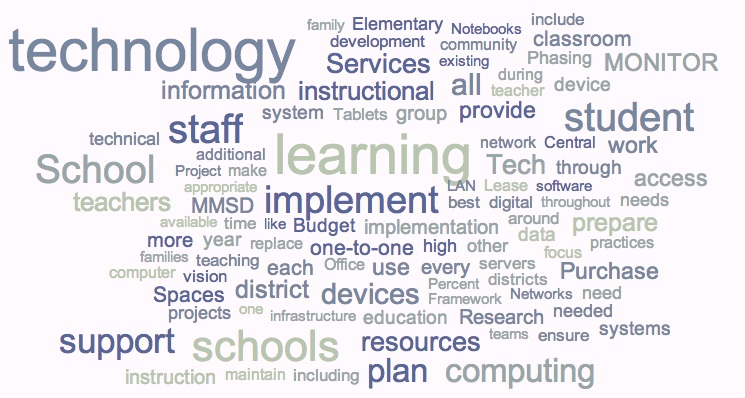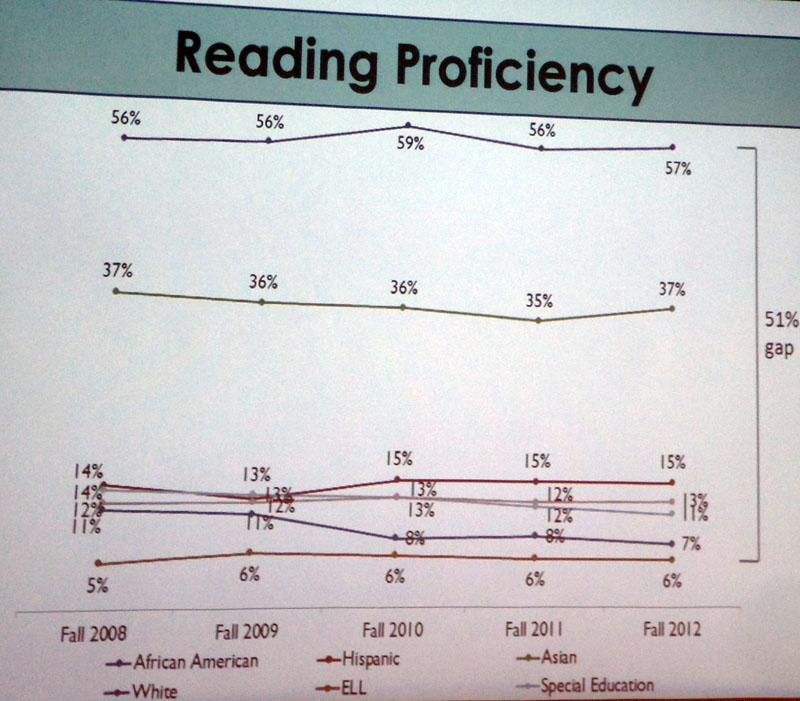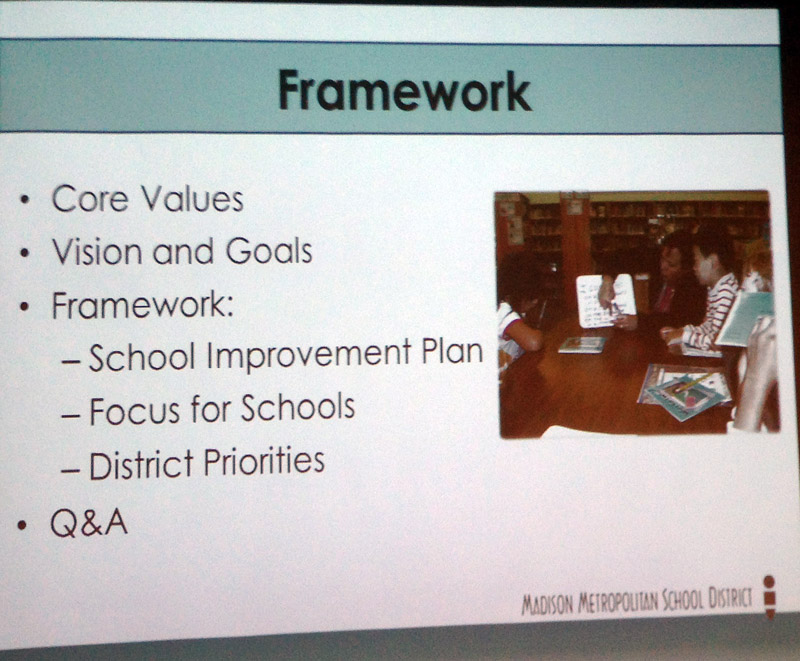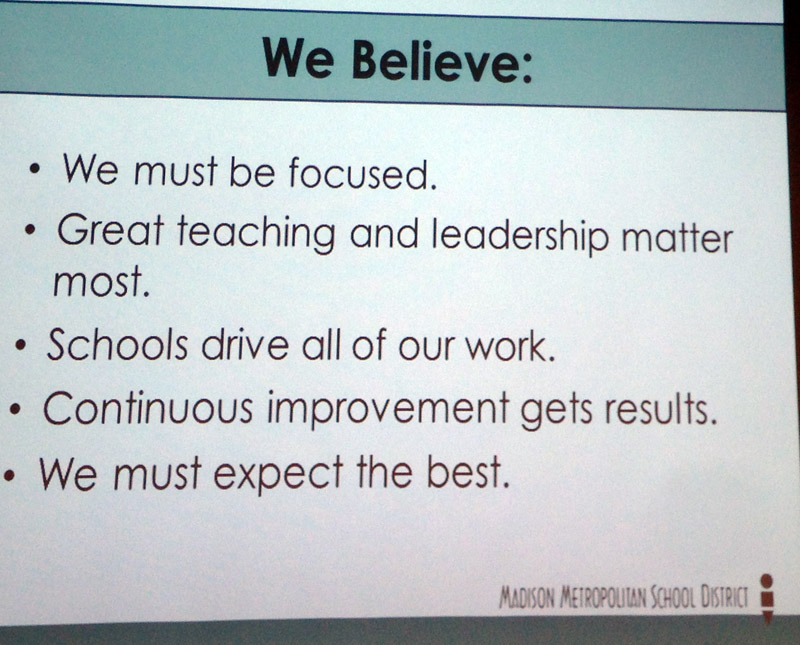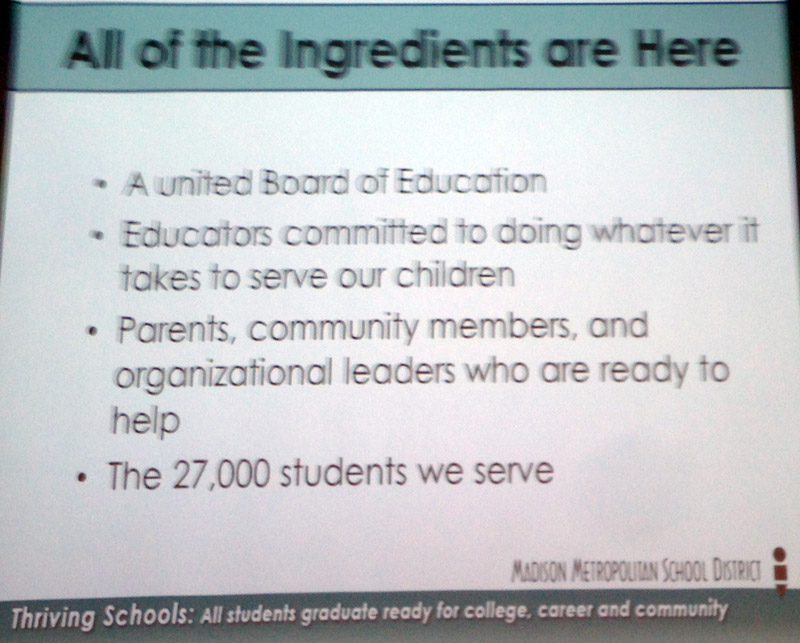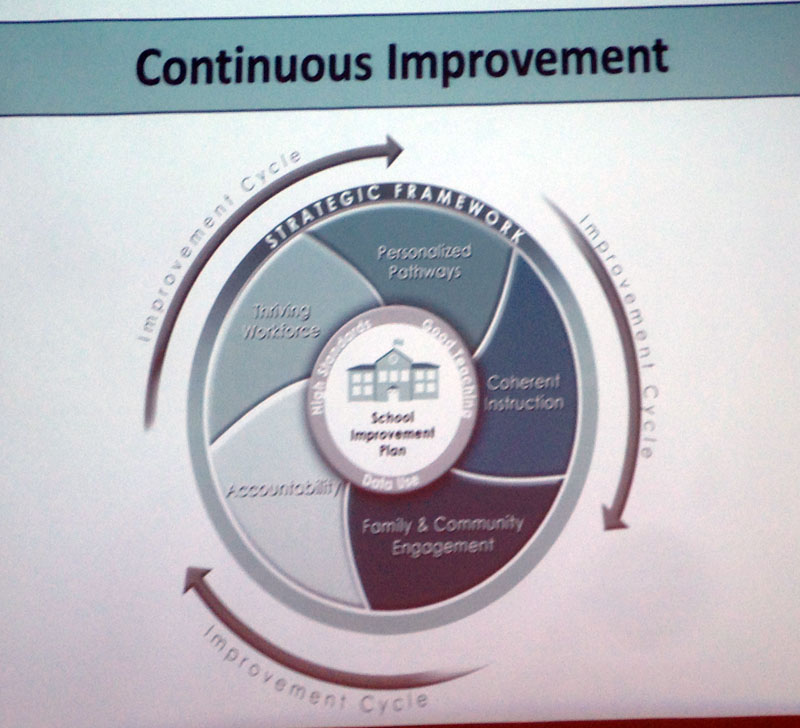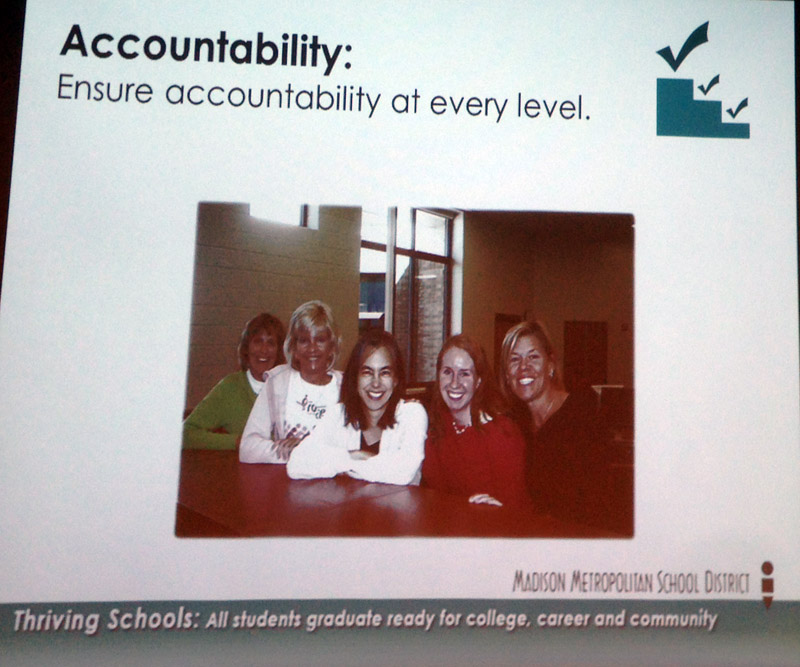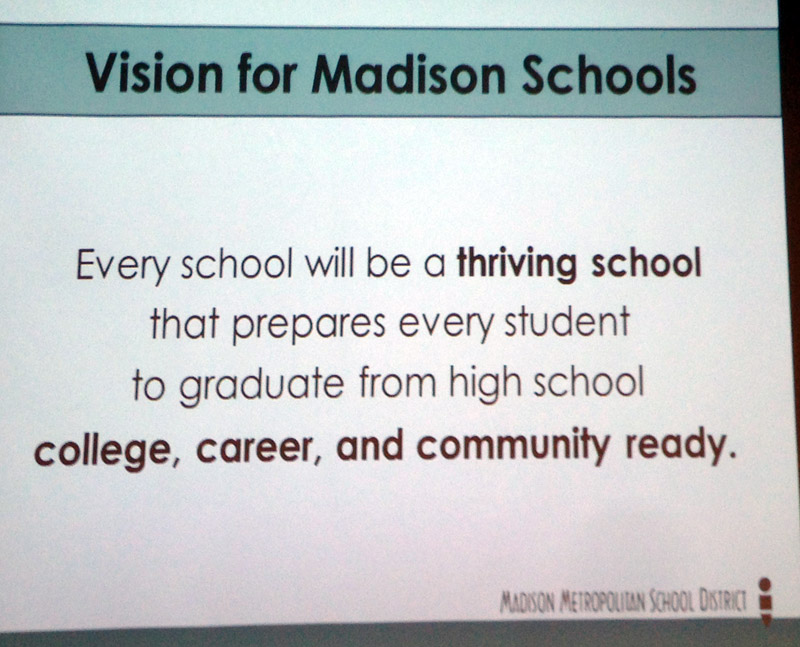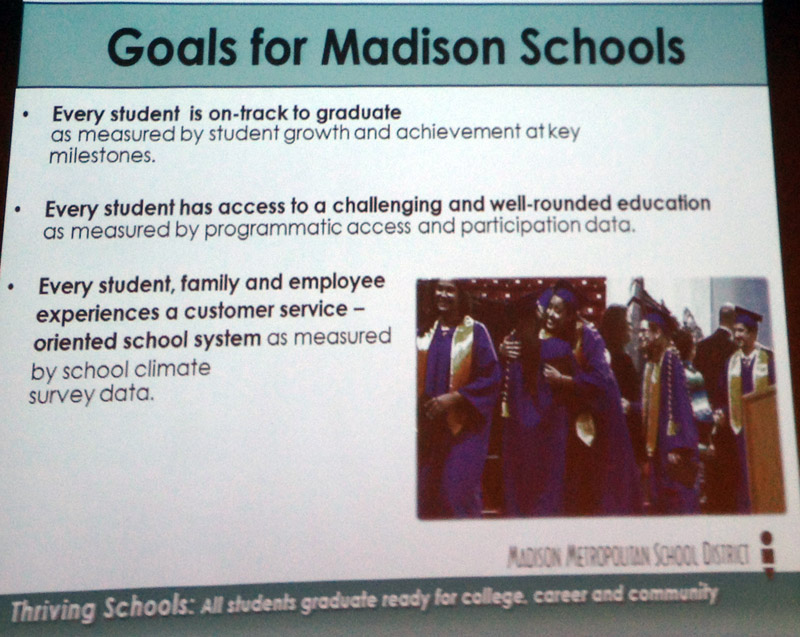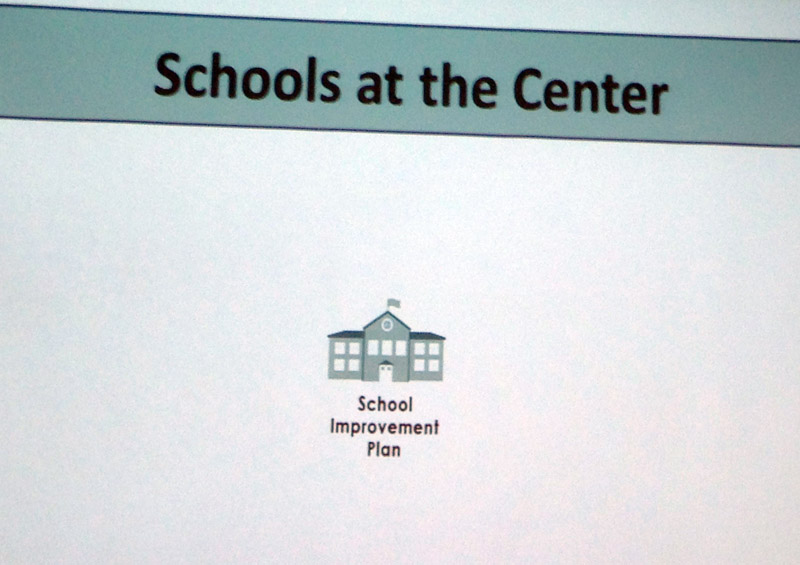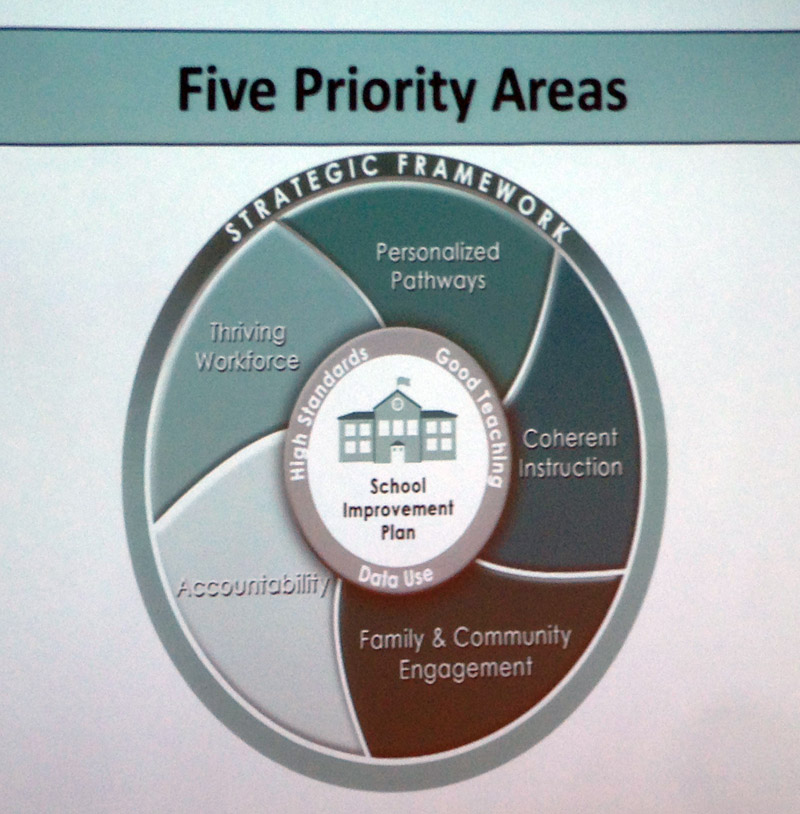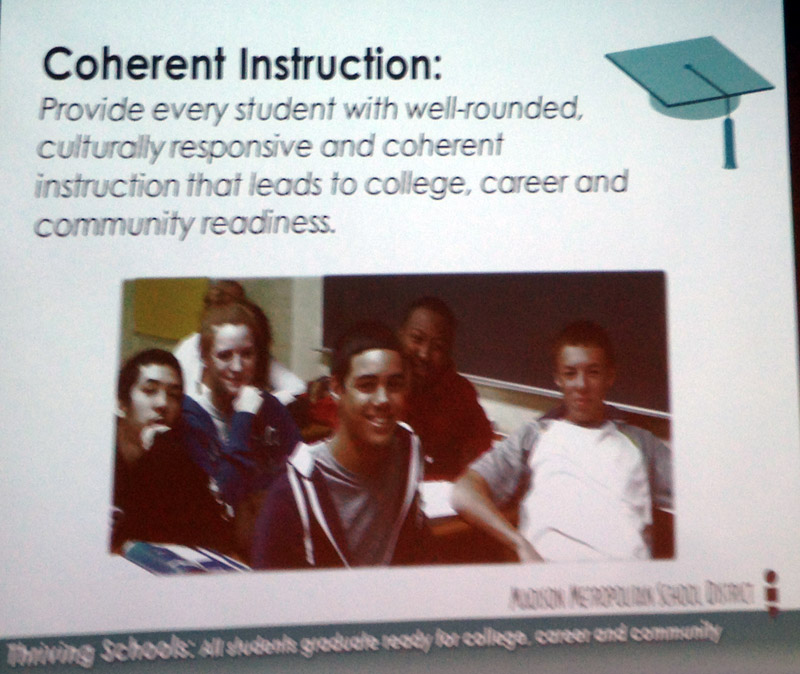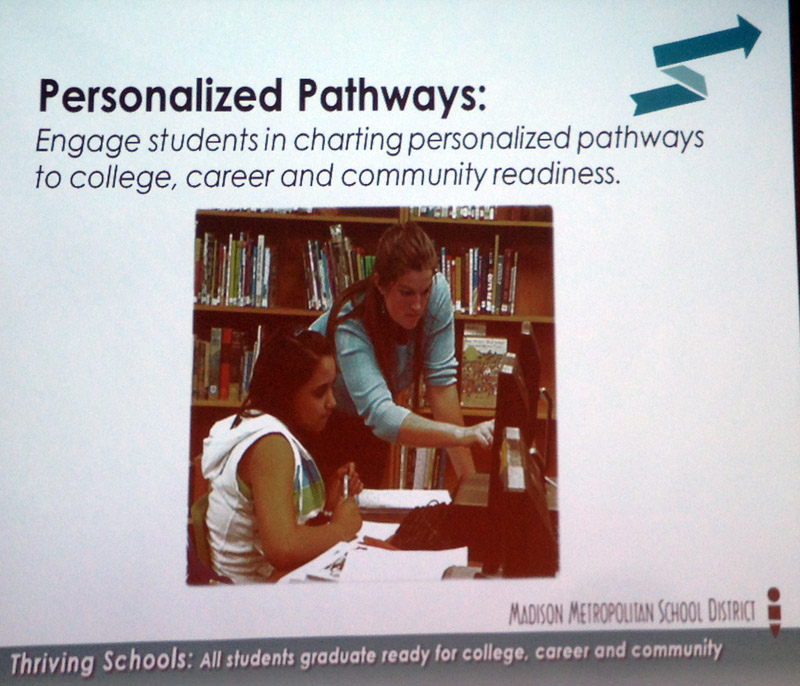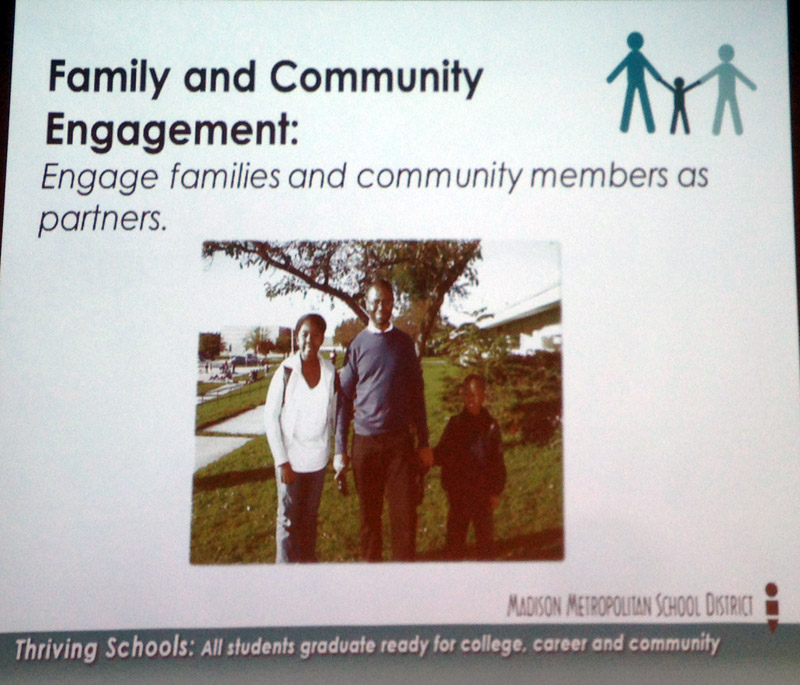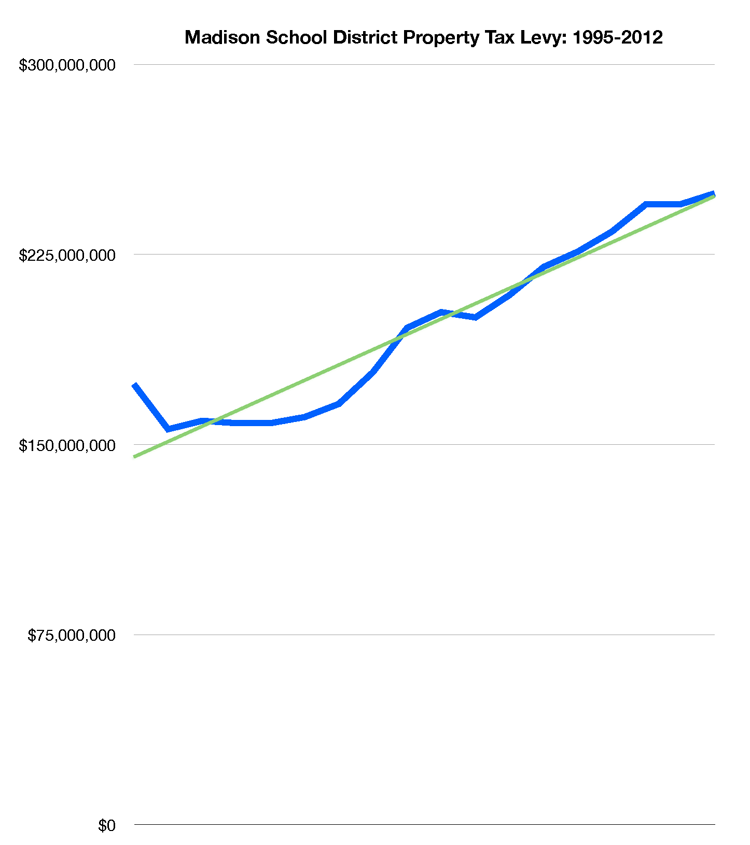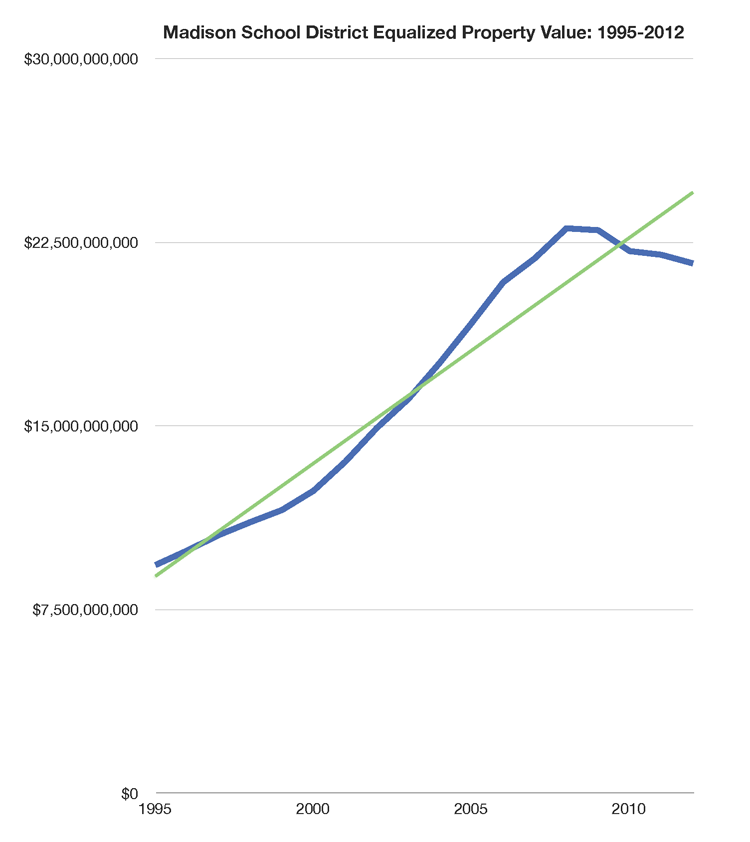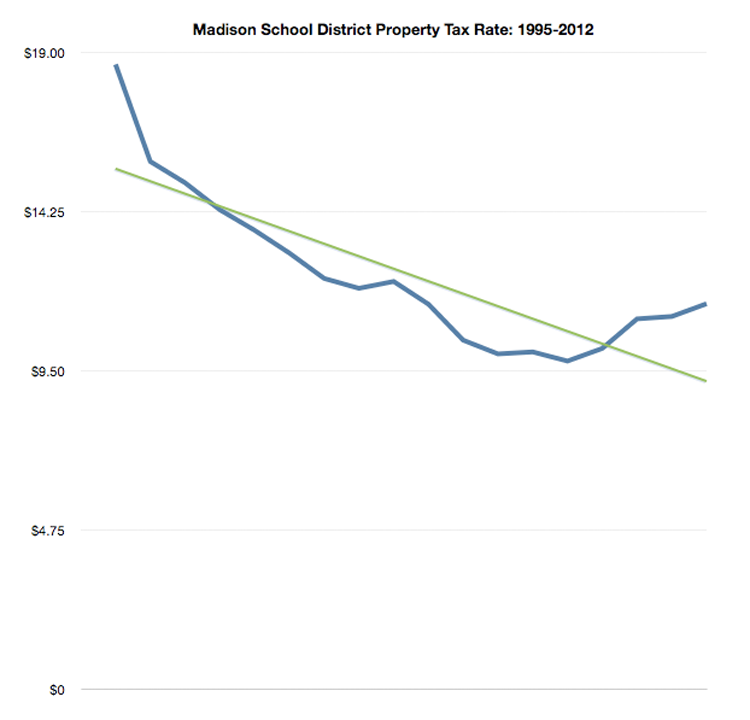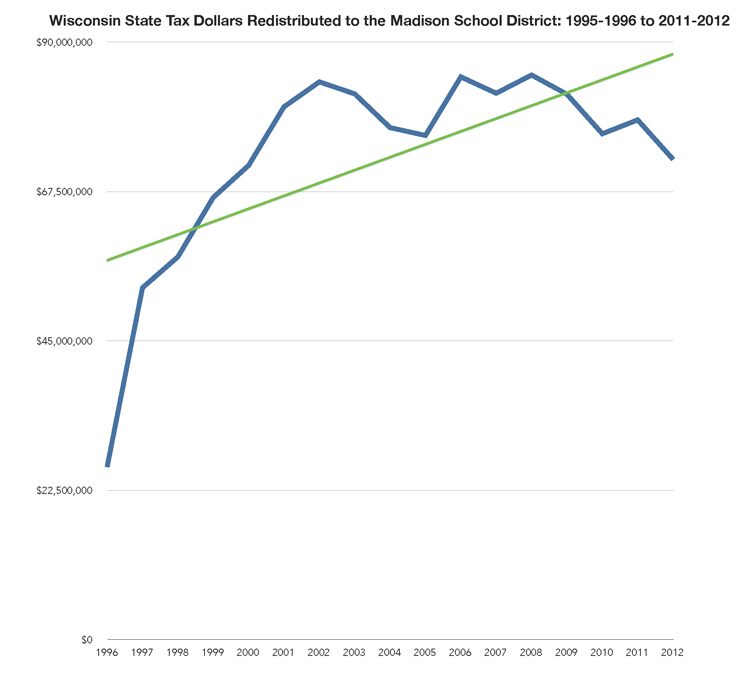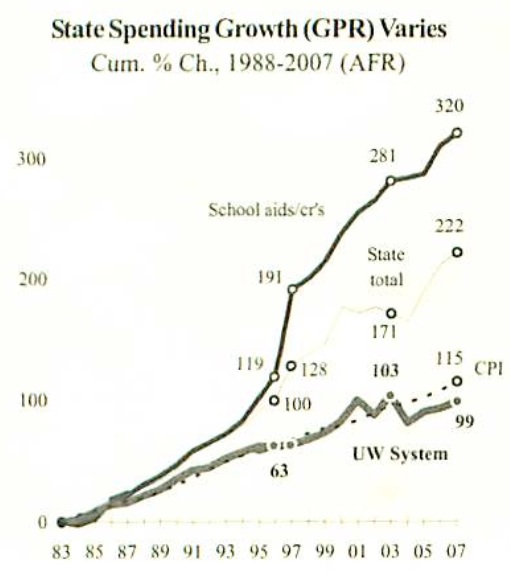Search Results for: "infinite Campus"
Online Systems and the Madison School District’s Remote Capabilities/Results (infinite Campus)
The lengthy 2020-2021 remote experience that Madison’s K-12 students endured made me wonder how the taxpayer funded school district is performing with online services. I was part of a group that reviewed the District’s acquisition of “Infinite Campus” software in the 2000’s. Having been through many software implementations, I asked the District’s then IT/Chief Information […]
“Teachers have access to materials in their classrooms that are not available at home,” (1) – despite million$ spent on Infinite Campus
Taxpayers have spent millions on Infinite Campus: Integration separates us from the competition. We are not just an SIS, we are an LMS, food service, district communicator, finance, human resources, and much more…all within a single product. 2012 (!) Madison School District Infinite Campus Usage Memorandum. Across our middle and high schools, a number of […]
Infinite Campus Prevails in Statewide Deal; Wisconsin company protests losing $15M state contract to Minnesota company
The Wisconsin company that lost out on a contract to run a student information system in the state’s schools protested the awarding of the bid to Minnesota’s Infinite Campus on Friday, arguing that the process was unfair.
Skyward Inc., of Stevens Point, said in its protest filed with the state Department of Public Instruction that it should be awarded the contract or all the bids should be thrown out. Skyward said DPI, as well as the committee of five unidentified people who evaluated the bids, “failed to provide a fair, transparent, and open process.”
Skyward, which employs about 270 people statewide, threatened to leave Wisconsin if it lost the contract that’s $15 million initially but could grow to as high as $80 million over the next decade. The company has been waging a public relations battle for the past two weeks since the state announced the contract would be going to Infinite Campus of Blaine, Minn., running full-page ads in newspapers across the state urging people to contact Gov. Scott Walker.School District of Beloit Director of Technology Victor Masliah said Beloit has been using Skyward Student system for 20 years. On Monday he said all districts have been asked to convert their student system side to Infinite Campus in the next five years. The latest state decision only affects the Skyward Student side, as Infinite Campus does not have a business side.
“The longer we wait, the higher our conversion costs may be as we continue to enter more types of data into our Skyward Student system daily,” he said.
Masliah said 80 percent of Wisconsin school districts use the business side of Skyward, as it’s recognized to be the best business system for schools.
The student side of Skyward costs approximately $52,000 per year, and the business side costs about $66,000 per year. Transitioning a system brings significant costs in data conversions, data migrations and trainings. For example, switching to a different Student system could potentially cost between $200,000 to $450,000.The evaluation was accurate and fair. That’s what Infinite Campus says about the process used to pick them to provide student information services for most schools across the Badger State.
Over the past couple weeks we’ve heard a lot from Skyward. They’re asking Wisconsin residents to encourage the state Department of Instruction to overturn its decision to go with Infinite Campus.
Today, we examined the actual score card that lead Infinite Campus, based in Minnesota, to get the job. That scorecard was released by Infinite Campus.
It ranks 31 different categories such as grading, attendance and technical support. Infinite Campus beat out six different candidates, including Skyward in nearly every category. The process by which the scores were awarded isn’t detailed, and the Department of Public Instruction said they won’t comment on the process.Much more on Infinite Campus, here.
The Wisconsin DPI’s scorecard (200K PDF).
Infinite Campus To Cover Wisconsin? DPI Intends to Proceed
The Wheeler Report, via a Matthew DeFour Tweet:
Today, the Department of Administration (DOA) issued a Notice of Intent to Award letter for the Statewide Student Information System (SSIS) project. DOA issued the letter to Infinite Campus, Inc., which was the highest scoring proposer in the SSIS competitive Request for Proposal process. The state will now move into contract negotiations with Infinite Campus for the company to establish and maintain DPI’s student information system for more than 440 school districts and non-district public charter schools in Wisconsin.
Cari Anne Renlund of the DeWitt, Ross & Stevens Law Firm conducted an extensive observation of the procurement, evaluation and selection process of the SSIS. Her report concluded:
1) The SSIS procurement, evaluation and selection process was open, fair, impartial and objective, and consistent with the RFP criteria;
2) The State and the Evaluation Team carefully followed the statutory and regulatory requirements applicable to the procurement process;
3) All proposing vendors were afforded an equal opportunity to compete for the contract award; and
4) The procurement, evaluation and selection process satisfied the goals and objectives of Wisconsin’s public contracting requirements.
Further, Renlund stated the Request for Proposal (RFP) “was drafted to identify the best possible vendor for the job at the best possible price.”many notes and links on Madison’s challenges with Infinite Campus.
A few additional notes:
1. Wisconsin firm may challenge loss of statewide school data pactA Stevens Point company providing school software to about half of Wisconsin’s districts has lost a bid to become the supplier of a new statewide student-information system, and now it’s moving to challenge the state’s decision to go with a different vendor.
The Wisconsin Department of Administration announced Friday that it intends to negotiate a contract with Minnesota’s Infinite Campus Inc. to create a centralized K-12 student data system. In response, Stevens Point-based Skyward Inc. called the evaluation process “flawed,” while some elected officials over the weekend urged the state to reconsider its decision.
The evaluation and selection process was already under heightened scrutiny after being paused and restarted in June, after it was discovered that Skyward had been offered tax breaks contingent on it winning the statewide contract.
Based in Blaine, Minn., Infinite Campus provides student data systems to about 10% of Wisconsin’s districts, including Milwaukee-area districts such as Greenfield, Whitnall, Elmbrook and New Berlin.
Financial details of the emerging contract have not been made public, but $15 million was initially appropriated to launch the project. The overall cost to implement and maintain the system will likely be millions more than that.
The blanket K-12 student-information system for Wisconsin is important because it would allow the Wisconsin Department of Public Instruction to better track student and teacher information in and between districts and schools.
Currently, each district and independent public charter school chooses its own system to track and manage student data. The robustness of these systems can vary from place to place, and none are obligated to “talk” to each other.
For the DPI, the goal is to raise the level of student performance by collecting and then synthesizing common data from all schools on everything from enrollment and student absences to discipline records and test-score results.
A common system also could assign teachers a unique identifier, allowing for richer data about their records of performance.2. Many school districts have successfully implemented complete student systems where parents can follow a course syllabus, all assignments, attendance, notes and grades. Madison has spent millions of dollars for a system that is at best partially implemented. What a waste.
3. Kurt Kiefer was instrumental in Madison’s acquisition of Infinite Campus. Kurt is now with the Wisconsin Department of Public Instruction. I like Kurt and was privileged to serve on a parent committee that evaluated student information systems. That said, I felt strongly then that no money should be spent on such systems if their use is not mandatory throughout the organization.
I wonder what sort of implementation strategies are part of this acquisition?
Infinite Campus & The Madison School District
Madison Teachers, Inc. Solidarity enewsletter (PDF), via a kind Linda Doeseckle email:
As the District contemplates consequences for those teachers who are not using Infinite Campus, MTI has heard from several members about the difficulty in meeting this District expectation. District Assistant Superintendent Joe Gothard sent a letter to all middle and high school teaching staff in late August, mandating that they use the grade book within IC and enter grades at least once weekly. While this poses challenges across the board, it has been especially difficult for specials teachers as they see literally hundreds of students each week.
MTI Executive Director John Matthews and Assistant Director Sara Bringman have spoken with Gothard about how to alleviate this burden for specials teachers. Gothard reports that he has spoken with principals and shared this message: “If specials teachers have large classes, and/or an A/B day (schedule), they would not be held to the standard of weekly input. At a minimum they should be using it for progress and grade reports.” Gothard’s accommodation should help allay concerns among specials teachers for not following the District’s earlier mandate.
Infinite Campus, Infinite Problems
Libby’s Board of Education Blog:
I conducted a (very) informal poll last night on Facebook–out of curiosity I asked my friends how often their teachers used Infinite Campus. The results didn’t shock me-most respondents answered either “half” or “some” of their teachers updated their gradebook regularly. Personally, “half” accurately describes my teachers. For some classes, I consistently know what grade I’m getting because the teachers add assignments often. However, many classes aren’t updated regularly, making it hard for me to know what assignments I’m missing and how to prioritize my time.
Infinite Campus is a six-year old program that the district has continuously struggled to implement. It’s in every school and every teacher has access, but the system isn’t always user friendly for teachers and staff inputting data. I’m pretty sure teachers don’t update because of the clunky interface. In fact, tonight’s Board Meeting confronted an issue with Infinite Campus: not everyone uses it.
Ed Hughes got mad tonight. After a string of public appearances condemning IC, disappointing news that the Infinite Campus developers weren’t flexible about changing and a suggestion that we abandon the Infinite Campus system entirely, Mr. Hughes practically shouted that “we should either require all teachers to be compliant or get some direction from the administration on what we need to change.”Much more on the Madison School District’s Infinite Campus experience, here.
Libby mentioned “developers weren’t flexible about changing”… There may well be opportunities for improvement. But, Infinite Campus has a large installed base. Why is it working in other Districts, and not Madison? My 18 years in the software business informs me that leadership is critical to successful implementation. It also means that such systems must be mandated. Waiting six years is a disaster, financially and from a credibility perspective.
Nearby Districts such as Verona have managed to implement student information systems. Why can’t Madison? Time to pull the plug if the Administration can’t make it happen.
Groundhog Day: Madison Schools’ Infinite Campus Usage Memorandum
The Madison School District (PDF):
In the spring of 2012 data was collected indicating a wide array of teacher grade book usage on Infinite Campus. Following the distribution of the letter on August 27, 2012 a number of concerns were brought forth regarding the use of grade book. Music and Physical Education teachers at the middle school level have larger class sizes and teach on an alternate day rotation in many cases. Currently, members of Curriculum and Assessment are working with Music and Physical Education teachers to develop a set of guidelines that are practical due to their schedules.
Following the end of the first quarter, November 7, we will gather data and measure the use of teacher grade book. The Assistant Superintendent for Secondary Schools will share the data with building principals to address areas of concern.
………
Across our middle and high schools, a number of you have utilized the Infinite Campus grade book.
Parents,guardians and other youth service providers appreciate the information regarding student progress. This year, the MMSD opened an online student enrollment option for families. The feedback is clear, a high percentage of MMSD families utilize Infinite Campus. The Research and Evaluation Department has analyzed the number of Infinite Campus grade book entries in all of our schools and it is evident to me that we have yet to reach our full implementation by having all teachers using the Infinite Campus grade book and consistently updating student progress. Therefore, it is my expectation that all teachers follow the below guidelines as we enter the 12-13 school year.Infinite Campus (million$ have been spent) usage issues continue…
A few links:
- June, 2009: Madison School Board OK’s 1 More Year of Infinite Campus, with More Oversite
- February, 2012: Madison School District Infinite Campus Usage Report
- March, 2010: An Update on the Madison School District’s Efforts to Increase Teacher Use of the “Infinite Campus” Student Portal
- Notes and links on Infinite Campus and the Madison School District.
- “Standards based” report cards were introduced just after the District licensed Infinite Campus. Unfortunately, the system did not support this change.
- Groundhog day.
Postponing Mandatory Teacher use of Madison’s Infinite Campus System
Background information: In 2010, the Board approved a number of administrative recommendations geared toward increasing usage of the Infinite Campus System. The current timeline requires all high school teachers to use grade-level appropriate Infinite Campus teacher tools by the end of the fourth quarter of the 2010-2011 school year.
The administration has been notified by the vendor that significant changes will be made to the Infinite Campus interface in July 2011. Accordingly, if training sessions were to continue as required to meet the current deadline, those same teachers would have to be trained on a new interface only months later.
It would be more prudent to wait until the new interface is available and require full implementation of the Infinite Campus teacher tools at the high schools by the end of the second quarter of the 2011-2012 school year.
D. BOE action requested: Postpone mandatory use of Infinite Campus teacher tools at the high schools until the end of the second quarter of the 2011-2012 school year.Much more on the Madison School District’s implementation of Infinite Campus, here.
A January, 2010 usage survey.
The system originally lifted off during the fall of 2007. I wonder how much has been spent on it without full use? This type of system can be a useful way for parents, teachers and students to communicate – if it is used…..
A Look at the Madison School District’s Use of Infinite Campus
Since Andie was in 6th grade – she’ll be entering 8th grade Sept. 1 – the Smith family has used Infinite Campus, an electronic data system that gives parents access to information about how students are doing in school. It often provides more information than the typical middle school student brings home and it helps parents know from week-to-week what’s going on in the classroom. Madison, like most other Dane County school districts, has been using some form of electronic communication system for the last several years.
“I don’t have to ask to look at her planner anymore,” says Smith. “And, her group of teachers at Toki wrote a weekly newsletter last year that I could read online. When your kids get into middle school, they’ve got more classes, and parents generally have fewer connections with the teachers so I really appreciate the way it works.”
For the first time this year, Smith, like the rest of the parents and guardians of the approximately 24,000 students in the Madison Metropolitan School District, is using the online system to enroll her children in class. She also has a son, Sam, who will be a 5th grader at Chavez Elementary this fall. District officials hope that giving parents a password and user ID at the enrollment stage will expand the number of parents using Infinite Campus. A primary goal is to help increase communication ties between home and school, which is a proven way to engage kids and boost academic achievement.
But whether all parents will take to the system remains to be seen. Despite the boom in electronic communication, there are plenty of homes without computers, especially in urban school districts like Madison where poverty levels are rising. The extent to which teachers will buy in is also unclear. Teachers are required to post report cards and attendance online, but things like test scores, assignments and quizzes will be discretionary.Much more on Infinite Campus and “Standards Based Report Cards”, here.
An Update on the Madison School District’s Efforts to Increase Teacher Use of the “Infinite Campus” Student Portal
Superintendent Dan Nerad 2.1MB PDF:
The Board of Education has shown concern with current levels of participation among staff, parents, and students in the use of the Infinite Campus student information system. This concern comes despite many efforts to engage the stakeholders with various professional development opportunities and promotional campaigns over the past three years. In December 2009, the Board was provided a summary from a staff survey conducted on the topic explaining why staff had been reluctant to use the teacher tools. That report is found as an attachment to this report (see Attachment 1).
A survey of Wisconsin school districts was completed to determine the standards for teacher use of student information system technologies in the state. The survey gathered information about the use of grade book, lesson planners, and parent and student portals. Responses were collected and analyzed from over 20 Wisconsin districts. Nearly all responding districts report either a requirement for online grade book use, or have close to 100 percent participation. (See Attachment 2).
Describe the action requested of the BOE
The administration is requesting that the Board of Education take action in support of the proposed action steps to enhance the overall use of the teacher and portal tools among our stakeholders.
The proposed time line for full teacher use of grade level appropriate Infinite Campus teacher tools is: High school teachers – 2011-2012 End of 4th Quarter, Middle school teachers – 2010-2011 End of 4th Quarter, Elementary school teachers – End of 4th Quarter, 2011-2012 (calendar feature only)Fascinating tone. I support the Board’s efforts to substantially increase usage of this system. If it cannot be used across all teachers, the system should be abandoned as the District, parents and stakeholders end up paying at least twice in terms of cost and time due to duplicate processes and systems.
Madison School District Infinite Campus Usage Report
Kurt Kiefer & Lisa Wachtel [1.4MB PDF]:
This report summarizes data on the use of Infinite Campus teacher tools and the Parent and Student Portal. Data come from a survey conducted among all teachers responsible for students within the Infinite Campus system and an analysis of the Infinite Campus data base. Below are highlights from the report.
- About half of all middle and high school teachers responsible for providing grades to students are using the grade book tool.
- Grade book use has declined over the past year at the middle school level due to the introduction of standards- based grading. In addition to the change in grading approach, the grade book tool in Infinite Campus does not handle standards-based grading as efficiently as traditional grading.
- Lesson Planner and Grade book use is most common among World Languages, Physical Education, and Science teachers and less common among fine arts and language arts/reading teachers.
- Grade book and other tool use is most common among teachers with less than three years of teaching experience.
- Seventy percent of teachers responding to the survey within these years of experience category report using the tools compared with about half of all other experience categories.
- Most of the other teacher tools within Infinite Campus, e.g., Messenger, Newsletters, reports, etc., are not being used due to a lack o!familiarity with them.
- Many teachers expressed interest in learning about how they can use other digital tools such as the Moodie leaming management system, blogs, wikis, and Drupal web pages.
- About one third of parents with high school stUdents use the Infinite Campus Parent Portal. Slightly less than 30 percent of parents of middle school students use the Portal. Having just been introduced to elementary schools this fall, slightly more that ten percent of parents of students at this level use the Portal.
- Parents of white students are more likely to use the Portal than are parents of students within other racial/ethnic subgroups.
- About half of all high school students have used the Portal at one time this school year. About one in five middle school students have used the Portal this year.
- Variation in student portal use is wide across the middle and high schools.
Follow up is planned during January 2010 with staff on how we can address some of the issues related to enhancing the use olthese tools among staff, parents, and stUdents. This report is scheduled to be provided to the Board of Education in February 2010.
Much more on Infinite Campus and the Madison School District here.
Madison School District’s Infinite Campus Teacher Tool and Parent/Student Portal Report: Approximately 2/3 of Middle and High School Parents don’t use it
This report summarizes data on the use of Infinite Campus teacher tools and the Parent and Student Portal. Data come from a survey conducted among all teachers responsible for students within the Infinite Campus system and an analysis of the Infinite Campus data base. Below are highlights from the report.
About half of all middle and high school teachers responsible for providing grades to students are using the grade book tool.
Grade book use has declined over the past year at the middle school level due to the introduction of standards- based grading. In addition to the change in grading approach, the grade book tool in Infinite Campus does not handle standards-based grading as efficiently as traditional grading.
Lesson Planner and Grade book use is most common among World Languages, Physical Education, and Science teachers and less common among fine arts and language arts/reading teachers.
Grade book and other tool use is most common among teachers with less than three years of teaching experience. Seventy percent ofteachers responding to the survey within these years of experience category report using the tools compared with about half of all other experience categories.
Most of the other teacher tools within Infinite Campus, e.g., Messenger, Newsletters, reports, etc., are not being used due to a lack of familiarity with them.
Many teachers expressed interest in learning about how they can use other digital tools such as the Moodie learning management system, blogs, wikis, and Drupal web pages.
About one third of parents with high school students use the Infinite Campus Parent Portal. Slightly less than 30 percent of parents of middle school students use the Portal.
Having just been introduced to elementary schools this fall, slightly more that ten percent of parents of students at this level use the Portal.
Parents of white students are more likely to use the Portal than are parents of students within other racial/ethnic subgroups.
About half of all high school students have used the Portal at one time this school year.
About one in five middle school students have used the Portal this year.
Variation in student portal use is wide across the middle and high schools.
Follow up is planned during January 2010 with staff on how we can address some ofthe issues related to enhancing the use of these tools among staff, parents, and students.
This report is scheduled to be provided to the Board of Education in February 2010.
Madison School Board OK’s 1 More Year of Infinite Campus, with More Oversite
Monday evening’s Madison School Board meeting included approval of another year of Infinite Campus along with (and this is quite important) a motion requiring that within six months, administration document use of IC and identify barriers to use where they exist, with the purpose of achieving 100% implementation by the end of 2012 or sooner.
Madison School Board Infinite Campus Discussion
Watch the discussion here. I’ve not had a chance to watch or listen to this yet, but I plan to. Much more on Infinite Campus here.
Via a kind reader’s email.
Advocating taxpayer supported K-12 curriculum transparency
Scott Girard: The report also pointed to the difficulty in accessing course materials via open records requests, citing expensive costs from certain districts to receive requested materials, including more than $5,000 from the Madison Metropolitan School District and more than $1,000 from the Kenosha Unified School District. The proposed bill would require districts to post […]
A chat with Jane Belmore
Scott Girard: Jane Belmore retired in 2005 after nearly three decades as a Madison teacher and principal. That wasn’t the end of her career with the Madison Metropolitan School District: She’s since been asked twice to lead when the district found itself between superintendents. Both turned out to be pivotal moments for the district. Cap […]
2020 Referendum: Commentary on adding another physical Madison School amidst flat/declining enrollment..
Scott Girard: Options at the new school under the recommendation would include designating it as a Community School — the district has four of those now — or creating specific programming like social-emotional learning, social justice or environmental education. Other ideas could still be added to that list as the planning process continues. Teachers have […]
Commentary on Madison’s Taxpayer Supported K-12 Schools, parents and online learning
Scott Girard: Harper and other parents who spoke with the Cap Times in the days following the decision said they hoped for more direct interaction with teachers and that the schedule or plans for their students could be communicated a week or two at a time. During a press conference following the virtual plan announcement, […]
Virtual schools see bump in interest as COVID-19 pandemic makes for uncertain fall
Logan Wroge: In a normal week, Parr fields about five or six phone calls. But in recent weeks, he said he’s been answering easily 70 calls a week from across the region, including many from Madison. Parr said he could see the online school’s enrollment, which was about 150 full-time students this year and a […]
Madison School District behavior plan updates would push for more alternatives to suspension
Scott Girard: After a larger overhaul a year ago, proposed updates to the Madison Metropolitan School District’s Behavior Education Plan for this fall would focus on “tweaks” to language and creating more alternatives to suspensions. The updates, presented to the School Board Monday night at its Instruction Work Group meeting, would add new language related […]
‘A lot of wasted time’: Milwaukee parents and advocates say MPS has been too slow to start virtual learning
Annysa Johnson: It’s been seven weeks since her 10-year-old son’s school was forced to close because of the coronavirus, and Crystal Manuel has been frustrated. She gets a weekly robocall from his principal at Townsend Elementary School in Milwaukee. But until Friday, she had yet to hear from any of his teachers. He shares the family laptop […]
Madison School District prepping for multiple fall scenarios, including online-only learning
Kelly Meyerhofer: Students in the Madison School District may not return to their schoolroom desks in the fall. That’s one of several scenarios district officials are preparing for in response to the COVID-19 pandemic, which led Gov. Tony Evers to shutter schools through the end of the current school year. Among the possibilities for fall […]
Madison high school students to be graded on pass/no pass; 3,000 students without internet (expensive K-12 system built for a long gone era)
Logan Wroge: Madison high school students will receive “pass” or “no pass” grades for the second semester as the COVID-19 pandemic disrupts traditional schooling, while more than 10% of Madison students lack internet access needed to take part in virtual learning, district officials said Wednesday. With the aim of not penalizing students for circumstances out […]
K-12 Governance Climate: Oligarchy and Pestilence
Joel Kotkin: Recreating the Conditions for Autocracy Throughout history, crises – like the Covid-19 pandemic – have been ideal opportunities for expanding centralized control of life, ostensibly for our own good. We are already seeing the potential rise of a new police state and in some countries, such as France, a rising incidence of informers, conspiracy […]
K-12 Tax, Spending & 2020 Referendum Climate: Mountains of Debt
Jon Hilsenrath: Student debt has become a heavier burden for households, and since 2007 it has tripled to $1.5 trillion, with large exposures among young individuals, according to Fed data. “We were talking about, when this is over, we want to downsize, maybe move into a townhome, being way more conservative in terms of major […]
How NYC moved the country’s largest school district online during the coronavirus pandemic
Lauren Feiner: On March 6, New York City high school principal Matt Willie was already preparing for the worst. After watching a news report that said the city’s Department of Education was preparing to close public schools amid the coronavirus crisis, Willie texted his assistant principal: “Prepare for the apocalypse.” Willie said his school, University […]
Madison School District looks to make virtual learning flexible, no ‘harm’ to grades amid COVID-19 pandemic
Logan Wroge: Madison students will have flexibility in their virtual school day schedule, teachers will hold remote office hours, and assessments during online learning will not “harm” a students’ grades. After three weeks out of class following an order for all Wisconsin schools to close to prevent the spread of the COVID-19 coronavirus, the Madison […]
Madison’s Virtual Learning Website is Live
Madison School District: We are committed to providing robust learning experiences for our students of MMSD during this time of school closure. Our instructional leaders are working to provide a virtual learning experience for our students that incorporates family engagement, limited screen time, and student overall health and emotional wellness. We recognize the impact that […]
LA Schools Go Online, but Seattle and others Say No
Danny Westneat: So Los Angeles announced an “unprecedented commitment” of $100 million in emergency funding to get all students who need them both devices and internet access for continuing their educations online this year. Compare to what school leaders have been saying here. Seattle Public Schools “won’t transition to online learning,” Superintendent Denise Juneau tweeted last week. “2 things […]
Madison teacher’s accidental text to parent: ‘I want to slap them through the phone!’
Chris Rickert: According to a police report released Wednesday to the State Journal under the state’s public records law, the parent, Tyeisha Ivy, considered the text a threat and reported it to police because she wanted it documented. Ringelstetter was not arrested, and no charges were filed in the case. Ivy told police that with […]
Commentary on Virtual Learning & The Madison School District
Logan Wroge: In an email Friday, district spokesman Tim LeMonds said the district is now aiming to roll out virtual learning the first week of April, but it “takes time and thoughtful planning to prepare an all inclusive virtual learning program.” “The complexities being addressed include there being a large number of our families who […]
Several Dane County districts move to online, remote education
Logan Wroge: As of now, the Madison School District isn’t moving to online schooling, but spokesman Tim LeMonds said the district is preparing for “distance learning alternatives as a requirement, if schools remain closed longer than what was initially expected.” In the meantime, Madison is providing “enrichment” activities for students and directing parents to online […]
Technology or Reading? Top Down vs. BYOD in Madison
Pat Schneider The Madison Metropolitan School District is launching a $27 million initiative that by 2018-19 will provide each student in grades second through twelve with a wireless computing device. Students in kindergarten and first grade will have computing access at a 2 to 1 ratio of students to devices. But the MMSD tech plan […]
Madison’s High School “Coursework Review”
Average GPA in Core Subjects in 8th and 9th Grades and Percentage of Students Receiving a D or F in a Core Course in 9th Grade, by Feeder School, 2010 – 2013: Madison School District 1.3MB PDF Presentation: In focus groups, several teachers noted what they perceived to be a lack of adequate preparation their […]
Con & Pro Commentary on the Madison School District’s Proposed Technology Plan
Madison School District Superintendent Jennifer Cheatham is a strong supporter of technology in the classroom. That’s why she is putting a $27.7 million computer plan in front of the School Board tonight.
But Cheatham also knows what really drives education, from kindergarten to high school.
“It’s the quality of teachers that matters the most,” she told the State Journal editorial board during a recent meeting.
Putting a tablet computer into the hands of every Madison student “will absolutely help teachers with instruction,” Cheatham said.
In our multi-device, always-wired world, understanding and using the latest technology is a must for today’s students and can cater to their individual needs and interests.
Ultimately, the issue is not how many devices are in a classroom but, rather, how those devices are used. The technology needs to offer more than whiz-bang special effects. It needs to open new paths to learning.
The high-dollar technology plan has attracted critics who question the cost and worry about additional “screen time,” especially for the youngest students.The Madison Metropolitan School District’s multi-million dollar Tech Plan is spending a lot of money on devices not proven to benefit student learning, according to an assistant professor of education at Madison’s Edgewood College.
In addition, the district isn’t giving teachers, parents or students opportunities to provide meaningful feedback on the plan, said Donna Vukelich-Selva in written remarks to the Madison school board shared Monday with The Cap Times.
The School Board is scheduled to vote Monday, Jan. 27, on what is now a revised, estimated $27.7 million, five-year plan that would greatly increase the use of computers in classroom instruction. The school district pared the proposal slightly, following a community update session last week, to include fewer devices for the youngest students. The plan now would provide one computer tablet in the classroom for about every two kindergartners and 1st-graders, and a one-to-one computer ratio for students in grades 2-12.
But Vukelich-Selva said concerns that the district is moving too fast on the Tech Plan, expressed by parents and teachers at the community update Jan. 22 at Memorial High School, were dismissed.
“It is clear that many significant stakeholders in the district were not taken into account,” she wrote.
The Madison school board first considered a draft of the plan on Jan. 13.
On hearing criticism that the proposal has advanced too quickly, Madison Superintendent Jennifer Cheatham said last week that the district has been “thorough and methodical in the development of the draft plan.”
Vukelich-Selva also said there was inadequate assessment of the impact of one-to-one computing on learning for younger students through fifth grade. She pointed to an apparent focus on technology itself rather than curricular goals.
“The huge numbers of ‘devices’ we are being told we need in our classrooms will help support a vastly expanded platform for more standardized testing,” she said.
Research shows that most large-scale evaluations of one-to-one computing initiatives have found mixed or no results, and underscore the importance of teacher mastery of using the devices, Vukelich-Selva wrote, referring specifically to an article in “Educational Leadership” from February, 2011, that is critical of one-to-one programs.Much more on the Madison School District’s Technology Plan, here.
One would hope that prior multi-million dollar technology implementations such as Infinite Campus, would be fully implemented first.
Madison School District’s Updated “Technology Plan” Slides
The Madison School District (1MB PDF):Every school will be a thriving school that prepares every student to graduate from high school college, career, and community ready.
Highlights of the Tech Plan
Devices available to all students when needed to personalize learning and increase digital literacy
Resources for staff that will strengthen high-quality instruction
Flexible learning spaces for discovery, collaboration, and creation
Upgraded infrastructure for fast, reliable systems
Improved data systems to help tailor learning based on students’ needs
Professional learning to engage staff in ongoing learning around instructional technologyMuch more on the District’s Technology Plan, including prior initiatives such as “Infinite Campus”, here.
Madison Superintendent Jennifer Cheatham proposes $31 million, five-year technology plan
All students in the Madison School District would have their own tablets or notebook computers by the 2018-19 school year under a five-year, $31 million plan proposed by Superintendent Jennifer Cheatham.
If approved, the plan would increase the district’s current
$1.5 million annual technology budget to $4.2 million in the 2014-15 school year to start upgrading the district’s network infrastructure, upgrade or equip classrooms and libraries with new technology or computers, and provide notebook computers to all district teachers and administrators. Elementary teachers also would get tablet computers under the plan.
Costs to upgrade are projected to increase each of the five years of the plan for a total of $31 million spent in that time. Afterward, the annual budget for technology would be about $7 million per year going forward.
…..
Madison School Board members, who formally received the plan at their meeting Monday, were mostly optimistic about the plan. Board member T.J. Mertz questioned whether the program needed to be as extensive as it’s proposed given what he said were other unmet needs in the district and given research that he called “universally disappointing” surrounding such initiatives.
Mertz said in an interview after Monday’s board meeting that he agrees with the majority of the investments in technology under the plan, “but then there’s a third or a quarter where I think it’s going overboard.”
As an example, Mertz said he questions whether every kindergarten student needs their own tablet computer.Prior to spending any additional taxpayer funds on new initiatives, I suggest that the District consider (and address) the status of past expensive initiatives, including:
Infinite Campus: is it fully implemented? If not, why? Why continue to spend money on it?
“Standards based report cards“.
Connected Math.
Small Learning Communities.
And of course, job number one, the District’s long term disastrous reading scores.
Madison already spends double the national average per student ($15k). Thinning out initiatives and refocusing current spending on reading would seem to be far more pressing than more hardware.
Madison Superintendent Cheatham’s Rotary Club Talk (audio & slides): “What will be different this time?”
15mb mp3 audio.
Superintendent Cheatham’s slides follow (4MB PDF version). I hope that the prominence of Madison’s disastrous reading scores – slide 1 – indicates that this is job one for our $15,000ish/student organization.
A few of the Superintendent’s words merit a bit of analysis:
1. “What will be different this time?” That rhetoric is appropriate for our Madison schools. I compiled a number of notes and links on this subject, here.
2. “Ready to partner with local businesses and other organizations”. Great idea. The substance of this would certainly be a change after the Madison Preparatory Academy IB Charter school debacle (Urban League) and, some years ago, the rejection of Promega’s kind offer to partner on Madison Middle Schools 2000.
3. Mentions “all Madison schools are diverse”. I don’t buy that. The range of student climate across all schools is significant, from Van Hise and Franklin to LakeView, Mendota and Sandburg. Madison school data by income summary. I have long been astonished that this wide variation continues. Note that Madison’s reading problems are not limited to African-American students.
4. Mentioned Long Beach and Boston as urban districts that have narrowed the achievement gap. Both districts offer a variety of school governance models, which is quite different than Madison’s long-time “one size fits all approach”.
5. Dave Baskerville (www.wisconsin2.org) asked a question about benchmarking Madison students vs. the world, rather than Green Bay and Milwaukee. Superintendent Cheatham responded positively to that inquiry. Interestingly, the Long Beach schools prominently display their status as a “top 5 school system worldwide”.
6. “Some teachers and principals have not been reviewed for as long as 7 years”. This points to the crux of hard decision making. Presumably, we are at this point because such reviews make no difference given rolling administrator contracts and a strong union umbrella (or floor depending on your point of view). Thus, my last point (below) about getting on with the hard decisions which focus the organization on job number one: reading.
Pat Schneider and Matthew DeFour summarize the Superintendent’s press release and appearance.
Finally, I found it a bit curious that the Superintendent is supporting spending (and related property tax growth) for current programs in light of the larger strategy discussed today along with the recent “expert review”. The review stated that the “Madison School District has resources to close achievement gap”
This would be a great time to eliminate some programs such as the partially implemented Infinite Campus system.
Superintendent Cheatham’s plan indicates that choices will be made so that staff and resources can focus on where they are most needed. I wholeheartedly agree. There is no point in waiting and wasting more time and money. Delay will only increase the cost of her “strategy tax“.
Madison’s Proposed Property Tax Increase: Additional links, notes and emails
I received a kind email from Madison School Board President Ed Hughes earlier today regarding the proposed property tax increase associated with the 2013-2014 District budget.
Ed’s email:Jim —
Your comparison to the tax rates in Middleton is a bit misleading. The Middleton-Cross Plains school district that has a mill rate that is among the lowest in Dane County. I am attaching a table (.xls file) that shows the mill rates for the Dane County school districts. As you will see, Madison’s mill rate is lower than the county average, though higher than Middleton’s. (Middleton has property value/student that is about 10% higher than Madison, which helps explain the difference.)
The table also includes the expenses/student figures relied upon by DPI for purposes of calculating general state aid for the 2012-13 school year. You may be surprised to see that Madison’s per-student expenditures as measured for these purposes is among the lowest in Dane County. Madison’s cost/student expenditures went up in the recently-completed school year, for reasons I explain here: http://tinyurl.com/obd2wty
EdMy followup email:
Hi Ed:
Thanks so much for taking the time to write and sending this along – including your helpful post.
I appreciate and will post this information.
That said, and as you surely know, “mill rate” is just one part of the tax & spending equation:
1. District spending growth driven by new programs, compensation & step increases, infinite campus, student population changes, open enrollment out/in,
2. ongoing “same service” governance, including Fund 80,
3. property tax base changes (see the great recession),
4. exempt properties (an issue in Madison) and
5. growth in other property taxes such as city, county and tech schools.
Homeowners see their “total” property taxes increasing annually, despite declining to flat income. Middleton’s 16% positive delta is material and not simply related to the “mill rate”.
Further, I continue to be surprised that the budget documents fail to include total spending. How are you evaluating this on a piecemeal basis without the topline number? – a number that seems to change every time a new document is discussed.
Finally, I would not be quite as concerned with the ongoing budget spaghetti if Madison’s spending were more typical for many districts along with improved reading results. We seem to be continuing the “same service” approach of spending more than most and delivering sub-par academic results for many students. (Note the recent expert review of the Madison schools Analysis: Madison School District has resources to close achievement gap.)
That is the issue for our community.
Best wishes,
Jim
Related: Middleton-Cross Plains’ $91,025,771 2012-2013 approved budget (1.1mb PDF) for 6,577 students, or $13,840.01 per student, roughly 4.7% less than Madison’s 2012-2013 spending.
The Collapse of Science, Not Housing, Ended the American Dream
The job of a scientist is to predict the future and get there first. We do this by looking for patterns in subtle clues; organizing the fragments thoughtfully to project their likely trajectory. It is this process that moves me to write this essay; in essence an epitaph from the future.
After giving a guest lecture at a departmental seminar in one of the nation’s leading medical schools a few weeks ago, I met with a group of eager graduate students and postdoctoral fellows over a lunch of sandwiches and chips as is customary for visiting speakers. I enjoy these sessions immensely as we go around the table and listen to each of the enthusiastic budding scientists share in turn their current research project with passion. This was an exceptionally bright and highly motivated group, but before any of us took a bite of lunch the meeting went off script. No one shared their research. Instead the group confessed fear. Uncertainty and bewilderment for the life choices they had made began to spill out.I am more optimistic than Fields. continuing the practices of the past does not guarantee similar future results. there are certainly opportunities to re-think our spending priorities. Locally, we could and should eliminate programs such as the expensive and partially implemented Infinite Campus system, among others.
Stagnant School Governance; Tax & Spending Growth and the “NSA’s European Adventure”
The Madison School District’s recent rhetoric around annual property tax increases (after a significant increase in redistributed state tax dollars last year and a “return to normal” this year) is, to the ongoing observer, unsurprising. We appear to be in the Rainwater era “same service” approach to everything, from million$ spent on a partially implemented Infinite Campus to long-term disastrous reading scores.
Steve Coll’s 5 July 2013 New Yorker column nails it:The most likely explanation is that President Obama never carefully discussed or specifically approved the E.U. bugging, and that no cabinet-level body ever reviewed, on the President’s behalf, the operation’s potential costs in the event of exposure. America’s post-September 11th national-security state has become so well financed, so divided into secret compartments, so technically capable, so self-perpetuating, and so captured by profit-seeking contractors bidding on the next big idea about big-data mining that intelligence leaders seem to have lost their facility to think independently. Who is deciding what spying projects matter most and why?
Much more on annual local property tax increases, here:
The Madison School Board should limit the school property tax hike to the rate of inflation next year, even if that means scaling back a proposed 1.5 percent across-the-board salary increase for school district employees, says member Mary Burke.
“I think in an environment where we’ve seen real wages in Dane County decrease, and a lot of people are on fixed incomes, we have to work as hard as possible to limit any increase to the inflation rate,” Burke said Tuesday in an interview.
…
But School Board discussions have focused around reducing the proposed salary hike, and cutting back on facility maintenance to pare down the $392 million proposed budget enough to bring the property tax increase to 4 or 5 percent, board President Ed Hughes told me.
The district under state law could increase its levy by as much as $18,385,847 or 9 percent. Keeping the increase to around the rate of inflation would mean an increase of less 2 percent.
…
Board member TJ Mertz can’t vote on salaries because his wife is a teacher’s aide with the school district, he told me, but he has long been outspoken in his belief in good pay for teachers to ensure the best academic achievement for students.
“As a citizen, I understand our staff needs to be compensated,” he said, adding that teachers have taken losses in take-home pay since they were required to begin making contributions to their pensions in 2011. “If the state won’t invest in our children, it has to come from the property tax,” he said.
Mertz said he would prefer a tax increase steeper than the 4 percent or 5 percent the board as a whole is focusing on. “I firmly believe the most important thing we can do is invest in our students; the question should not be what property tax levy can we afford,” he said.I appreciate Schneider’s worthwhile questions, including a discussion of “program reviews”:
Several School Board members interviewed for this story stressed that the 2013-2014 budget will be a transitional one, before a broad re-evaluation of spending planned by Cheatham can be conducted.
Yet, it would be useful to ask if in fact programs will be reviewed and those found wanting eliminated. The previous Superintendent, Dan Nerad, discussed program reviews as well.
Madison Schools’ 2013-2014 Budget Charts, Documents, Links, Background & Missing Numbers.
The Madison School Board seat currently occupied by Mr. Hughes (Seat 7, and Seat 6 – presently Marj Passman) will be on the Spring, 2014 ballot (candidate information is available at the Madison City Clerk’s website).
Skyward: State gave competitor unfair bidding edge for school IT system
In choosing a company to design a computer-based student-information system for all of Wisconsin’s public schools, the state put a local bidder at a disadvantage after it removed an evaluator and incorrectly calculated cost proposals, according to a protest filed Friday.
The challenge to the outcome of the Department of Administration’s procurement process for a statewide student-information system vendor comes from Stevens Point-based Skyward Inc., which provides school management software to 221 Wisconsin school districts covering 39% of the state’s students.
The company’s formal protest comes two weeks after the department announced it intended to negotiate a contract with rival bidder Infinite Campus, a school software company from Minnesota serving fewer districts in Wisconsin. The department said Infinite Campus earned the highest technical score and lowest cost bid.
The contract to build the system could be worth between $60 million and $90 million over the next decade, according to details provided by Skyward.
Department spokeswoman Stephanie Marquis defended the state’s procurement procedure, saying that it identified the best product for the best price in a transparent process free of outside influence.
“Standards based report cards and the Milwaukee Schools
Milwaukee Public Schools plans to expand districtwide a pilot program in which schools ditch traditional letter grades. Instead of A, B, C, D and F, teachers will compare students to a list of things the state expects students to know on core subjects in each grade and mark their skills advanced, proficient, basic or minimal. It’s called a “standards-based report card.”
The idea has some merits and several significant flaws.
Parents and students benefit from objective, specific standards for academic performance. If a father knows Julia must learn to define a story’s theme in second grade, he can ask her to do so when they read together. Grading metrics can also help counter grade inflation, where teachers give students high marks they have not earned. A 2005 ACT study found high school grades inflated 12.5% between 1991 and 2003.The Madison School District implemented the ill-advised middle school “standards – based report cards” several years ago. Unfortunately, this initiative was incompatible with the multi-million dollar “Infinite Campus” system.
Madison School District Strategic Plan Update
Madison School District 600K PDF:.
I recently attended the third annual update to the 2009 Madison School District Strategic Plan. You can follow the process via these notes and links.
I thought it might be useful to share a few observations on our local public schools during this process:
- General public interest in the schools continues to be the exception, rather than the norm.
- I sense that the District is more open to discussing substantive issues such as reading, math and overall achievement during the past few years. However, it does not appear to have translated into the required tough decision making regarding non-performing programs and curriculum.
- MTI President Kerry Motoviloff recent statement that the District administration has “introduced more than 18 programs and initiatives for elementary teachers since 2009”.
- Full teacher Infinite Campus use remains a goal, despite spending millions of dollars, money which could have gone elsewhere given the limited implementation. Unfortunately, this is a huge missed opportunity. Complete course syllabus, assignment and gradebook information would be a powerful tool when evaluating achievement issues.
- The implementation of “standards based report cards” further derailed the Infinite Campus spending/implementation. This is an example of spending money (and time – consider the opportunity cost) on programs that are actually in conflict.
- The District continues to use the oft criticized and very low benchmark WKCE as their measure. This, despite starting to use the MAP exam this year. Nearby Monona Grove has been using MAP for some time.
- Three Madison School Board members attended: Mary Burke, James Howard and Ed Hughes.
- UW-Madison school of Education dean Julie Underwood attended and asked, to my astonishment, (paraphrased) how the District’s various diversity programs were benefiting kids (and achievement)?
The only effective way forward, in my view, is to simplify the District’s core mission to reading, english and math. This means eliminating programs and focusing on the essentials. That will be a difficult change for the organization, but I don’t see how adding programs to the current pile benefits anyone. It will cost more and do less.
Less than 24 hours after I attended the MMSD’s Strategic Plan update, I, through a variety of circumstances, visited one of Milwaukee’s highest performing private/voucher schools, a school with more than 90% low income students. The petri dish that is Milwaukee will produce a far more robust and effective set of schools over the next few decades than the present monolithic approach favored here. More about that visit, soon.
Parents understand an ‘A,’ but what about a ‘yellow’ on a school report card?
Parents might know what an A means when they see it on a report card, but what if their school was graded “blue?”
The state Education Department is backing away from its plan to grade schools using three colors — red, yellow and green — to one that would use five colors, saying it would be more helpful to parents.
But several education advocacy groups say the new plan is better than the “traffic light,” but still falls short of a report card system they said works well in other states and gives parents a clear indication of a school’s progress.
“We’re glad to hear about the five categories — a big improvement for the new public reporting system,” said Amber Arellano, executive director of the Education Trust -Midwest. “We still think parents intuitively understand an A to F system better than a color system. For example, what does “yellow” mean to a parent in terms of school quality?”Madison adopted a “standards-based” report card for middle schools several years ago. Unfortunately, it was not, at the time, compatible with the then new “infinite campus” system. Has this changed?
Is $14,858.40 Per Student, Per Year Effective? On Madison Superintendent & School Board Accountability…
Oh, the places we go.
I’m glad Matt DeFour and the Wisconsin State Journal obtained the most recent Superintendent Review via open records. We, as a community have come a long way in just a few short years. The lack of Board oversight was a big issue in mid-2000’s competitive school board races. Former Superintendent Art Rainwater had not been reviewed for some time. These links are well worth reading and considering in light of the recent Superintendent review articles, including Chris Rickert’s latest. Rickert mentions a number of local statistics. However, he fails to mention:
- Despite spending nearly $15,000 per student annually, our Reading Results, the District’s job number one, need reform. 60% to 42%: Madison School District’s Reading Recovery Effectiveness Lags “National Average”: Administration seeks to continue its use. This is not a new topic.
- The District’s math program has been an issue for some time, as well (Math Forum).
- How does Madison compare to the World, or other US cities? We can and should do much better.
- What is happening with Madison’s multi-million dollar investment (waste?) in Infinite Campus? Other Districts have been far more successful implementing this important tool.
- Are the District’s tax expenditures well managed?
With respect to the current Superintendent Review, the job pays quite well (IRS income distribution data: table 7), so I believe the position should be fully accountable to parents and taxpayers. Matthew DeFour:
In 2014, Madison superintendent Dan Nerad qualifies for a $37,500 payment for six years of service, which like Gorrell’s would be paid into a retirement account. Nerad already receives an annual $10,000 payment into his retirement account, which is separate from his state pension and in addition to a $201,000 yearly salary.
More, here.
The current rhetoric is quite a change in just 8 years. (Why did things change? A number of citizens care, decided to run for school board – won – and made a difference…) I certainly hope that the Board and community do not revert to past practice where “we know best” – the status quo – prevailed, as the Obama Administration recently asserted in a vital constitutional matter:Holder made clear that decisions about which citizens the government can kill are the exclusive province of the executive branch, because only the executive branch possess the “expertise and immediate access to information” to make these life-and-death judgments.
Holder argues that “robust oversight” is provided by Congress, but that “oversight” actually amounts to members of the relevant congressional committees being briefed. Press reports suggest this can simply amount to a curt fax to intelligence committees notifying them after the fact that an American has been added to a “kill list.” It also seems like it would be difficult for Congress to provide “robust oversight” of the targeted killing program when intelligence committee members like Sen. Ron Wyden (D-Ore.) are still demanding to see the actual legal memo justifying the policy.More, here on the political class and the legal system.
The choice is ours. Use our rights locally/nationally, or lose them.
A look back at previous Madison Superintendents.
High expectations surely begin at the top.
Budget & Wisconsin School Accountability
The perils of another strategy, finding lower-cost ways to deliver state services, shows up in another Journal Sentinel story this morning on the notable absence of a common school accountability system for all schools receiving public revenue in a new piece of education legislation. Erin Richards writes of the bill:
What is not mentioned in the story is that an identical public, private, and charter school accountability system is functionally impossible, and undesirable. The presence of religion in private choice schools for example requires that the schools spend (and document the purpose of) every dollar they receive annually through the choice program so as not to have a surplus that could be seen as aiding religion. In comparison, having and carrying over a surplus in a public school district may actually be a sign of responsible budgeting. And the heart of the charter school concept is a third party authorizer that serves as the accountability agent. A common accountability system undermines the very idea of a charter school.
More important, if choice and charter face identical public school rules and regulations, there is every reason to expect them to be nothing more than poorly funded public schools that may save the state money, but not increase educational quality. What is needed is a way to ensure all of our schools are accountable and transparent, not identical regulation.
Related: notes and links on Madison’s multi-million dollar Infinite Campus expedition… I’m not sure that a state-wide system makes sense. Rather, the state might create a set of data reporting “standards” that allows local Districts to collect and manage information in the way that they prefer.
More from Erin Richards Wisconsin Accountability article, here:
Its elements include:
A proposal to create a fund to which private donors could contribute money to fund successful literacy and early-childhood development programs.
A proposal to require schools to annually assess all kindergartners for reading readiness.
A proposal to require new elementary and special education teachers to pass a more rigorous reading test.
A proposal for education schools to submit to DPI a list of graduates and their graduation dates, so that the state can better link practicing teachers back to their institution of training.
A proposal to evaluate the performance of all public school teachers and principals.
FAQ’s on Madison’s Latest Collective Bargaining Agreement
Madison School Board Member Ed Hughes:
After a marathon bargaining session that lasted from Friday morning into early Saturday morning, the school district and MTI, our teachers union, settled on the terms of a two-year collective bargaining agreement for our teachers and four other bargaining units that will take effect on July 1. As is true for most negotiations, the terms of the final agreement varied considerably from the parties’ initial offers (discussed in my previous post). The school board ratified the agreement on Saturday and MTI membership voted to approve the pacts today, Sunday.
Here are some frequently asked questions about the agreement along with my responses.
What is your reaction to the settlement?I wonder if any provisions were included that address the District’s “infinite campus” implementation challenges?
Madison School Board Priorities: Ethics, Achievement, or ?
TJ Mertz makes a great point here:
Last up, is “Next Steps for Future Board Development Meetings and Topics.’ Board development is good and important, but with only 2/3 of the term left I hate to see too much time and energy devoted to Board Development.
I keep coming back to this. Every year about 1/3 of the time and energy is devoted to budget matters, that leaves 2/3 to try to make things better. Put it another way; it is September, budget season starts in January. Past time to get to work.
This just leaves the closed meeting on the Superintendent evaluation. Not much to add to what I wrote here. My big point is that almost all of this process should be public. I will repost the links to things that are public:Charlie Mas continues to chronicle, in a similar manner to TJ, the Seattle School Board’s activities.
In my view, the Madison School Board might spend time on:
- Public Superintendent Review, including oversight of the principal and teacher review process. Done properly, this should improve teaching effectiveness over time. This process should include full implementation of Infinite Campus. Infinite Campus is a potentially powerful tool to evaluate many activities within the District.
- Implement a 5 year budget.
- Evaluate ongoing MMSD Programs for their effectiveness, particularly from a spending and staffing perspective.
Voters will have another chance to weigh in on the Madison School Board during the spring, 2011 election, when seats currently occupied by Ed Hughes and Marj Passman will be on the ballot. Those interested in running should contact the City of Madison Clerk’s office.
Update: I received the draft Madison School Board ethics documents via a Barbara Lehman email (thanks):
- Board Member Ed Hughes 241K PDF
Presently we do not have a policy that describes expectations regarding the performance of School Board members. The Committee developed this list on the basis of similar policies adopted by other Boards as well as our own discussion of what our expectations are for each other. The Committee members were able to reach consensus on these expectations fairly quickly.
Expectation No.4 refers to information requests. We realize that current MMSD Policy 1515 also refers to information requests, but our thinking was that the existing policy addresses the obligation of the superintendent to respond to information requests. We do not currently have a policy that addresses a Board member’s obligation to exercise judgment in submitting information requests.
Expectation No. 10 is meant to convey that School Board members hold their positions 24-hours a day and have a responsibility to the Board always to avoid behavior that would cast the Board or the District in a poor light.How might Number 10 affect an elected Board member’s ability to disagree with District policies or activities?
- Outgoing Madison School District Counsel Dan Mallin 700K PDF.:
These paragraphs are a modification from existing language. Although the overall intent appears to remain similar to existing policy, I recommend the existing language because I think it does a better job of expressly recognizing the competing interests between the “beliefstatements” and a Board Member’s likely right, as an individual citizen (and perhaps as a candidate for office while simultaneously serving on the Board) to accept PAC contributions and or to make a statement regarding a candidate. Perhaps the langnage could make clear that no Board Member may purport to, or attempt to imply, that they are speaking for the School Board when making a statement in regard to a candidate for office. That is, they should be express that they are speaking in the individual capacity.
- Draft ethics policy 500K PDF:
The Board functions most effectively when individual Board Members adhere to acceptable professional behavior. To promote acceptable conduct of the Board, Board Members should:
- Outgoing Counsel Dan Mallin’s 7/15/2010 recommendations.
Value Added Models& Student Information Systems
147K PDF via a Dan Dempsey email:
The following abstract and conclusion is taken from:
Volume 4, Issue 4 – Fall 2009 – Special Issue: Key Issues in Value-Added Modeling
Would Accountability Based on Teacher Value Added Be Smart Policy? An Examination of the Statistical Properties and Policy Alternatives
Douglas N. Harris of University of Wisconsin Madison
Education Finance and Policy Fall 2009, Vol. 4, No. 4: 319-350.
Available here:
http://www.mitpressjournals.org/doi/pdfplus/10.1162/edfp.2009.4.4.319
Abstract
Annual student testing may make it possible to measure the contributions to student achievement made by individual teachers. But would these “teacher value added” measures help to improve student achievement? I consider the statistical validity, purposes, and costs of teacher value-added policies. Many of the key assumptions of teacher value added are rejected by empirical evidence. However, the assumption violations may not be severe, and value-added measures still seem to contain useful information. I also compare teacher value-added accountability with three main policy alternatives: teacher credentials, school value-added accountability, and formative uses of test data. I argue that using teacher value-added measures is likely to increase student achievement more efficiently than a teacher credentials-only strategy but may not be the most cost-effective policy overall. Resolving this issue will require a new research and policy agenda that goes beyond analysis of assumptions and statistical properties and focuses on the effects of actual policy alternatives.
6. CONCLUSION
A great deal of attention has been paid recently to the statistical assumptions of VAMs, and many of the most important papers are contained in the present volume. The assumptions about the role of past achievement in affecting current achievement (Assumption No. 2) and the lack of variation in teacher effects across student types (Assumption No. 4) seem least problematic. However, unobserved differences are likely to be important, and it is unclear whether the student fixed effects models, or any other models, really account for them (Assumption No. 3). The test scale is also a problem and will likely remain so because the assumptions underlying the scales are untestable. There is relatively little evidence on how administration and teamwork affect teachers (Assumption No. 1).Related: Value Added Assessment, Standards Based Report Cards and Los Angeles’s Value Added Teacher Data.
Many notes and links on the Madison School District’s student information system: Infinite Campus are here.
Tension grows over Seattle teacher evaluations
Seattle Public Schools wants teacher evaluations and student performance joined at the hip, but the teachers’ union is taking issue with how the district plans to fuse those two factors.
A proposal that would tie teacher evaluations to student growth prompted a 2,000-word refutation e-mail from the Seattle Education Association earlier this week, a sign of friction in ongoing contract negotiations.
“Their mechanized system is one of minimal rewards and automated punishments,” union leaders wrote to members Wednesday.
That statement was sent in response to an e-mail teachers received this week from public schools Superintendent Maria Goodloe-Johnson. She detailed how the school plans to roll out parts of its bargaining proposal — specifically factors related to how teachers’ performances are evaluated.
The district is proposing an four-tier evaluation system that would roll out over two years. Teachers who chose to be evaluated base on to “student growth outcomes and peer and student feedback” would be eligible for perks, including an immediate 1 percent pay increase, eligibility for stipends and other forms of “targeted support.”I was impressed with Susan Troller’s recent article on Teacher Accountability and the Madison School District, particularly her inquiry to Lisa Wachtel:
The district’s recent decision to provide professional development time for middle and high school teachers through an early release time for students on Wednesdays is part of this focus, according to Wachtel. The district has sponsored an early release time for elementary school teachers since 1976.
She admits there isn’t any data yet to prove whether coaching is a good use of resources when it comes to improving student achievement.
“Anecdotally we’re hearing good things from a number of our schools, but it’s still pretty early to see many specific changes,” she says. “It takes consistency, and practice, to change the way you teach. It’s not easy for anyone; I think it has to be an ongoing effort.”This is certainly not the only example of such spending initiatives. Jeff Henriques has thoughtfully posted a number of very useful articles over the years, including: Where does MMSD get its numbers from? and District SLC Grant – Examining the Data From Earlier Grants, pt. 3. It appears that these spending items simply reflect growing adult to adult programs within the K-12 world, or a way to channel more funds into the system.
I believe it is inevitable that we will see more “teacher evaluation” programs. What they actually do and whether they are used is of course, another question.
Ideally, every school’s website should include a teacher’s profile page, with their CV, blog and social network links, course syllabus and curriculum notes. Active use of a student information system such as PowerSchool, or Infinite Campus, among others, including all assignments, feedback, periodic communication, syllabus, tests and notes would further provide useful information to parents and students.
Google Apps (email, docs & calendar) for Madison School District Staff & Students Proposed by the Administration
Technical Services has planned to replace our Eudora student email system since 2008 and identified this as Activity 50 in the June 2010 Technology Plan, approved by the Board of Education. Consideration has also been given to replacing our GroupWise staff email system since instability of the web version ofthis system became a problem beginning in October 2009. Demands on our staff email system have always been greater due to our need for highly secure, robust and reliable local and remote access, shared calendaring, and integration with an archival system allowing for a seven year retention. This has been a complicated system and is core to many critical business and legal functions ofthe District.
An request for proposals (RFP) for alternatives to replace our student email, with the caveat that our staff email might be considered as well, was released in fall 2009, generating responses from nine vendors, representing 11 products. Both Microsoft’s Live@edu and Google’s Gmail have been final contenders for student email and following product reviews in March by 13 teachers, six technical staffand four administrators, consensus built around migrating both student and staff email to Gmail. In addition to email, Google Apps for Education includes access to a wide variety ofGoogle tools including Docs (word processing, spreadsheets, presentations, fonus) and Google calendar.
Financial considerations:
- Moving to Gmail for both students and staff will enable free email account hosting and cost $67,320/yr for the use ofPostini for staff email archiving. We will continue to use Novell’s ZenWorks for desktop application maintenance, at a cost of $28,000/yr through the 2010-2011 fiscal year. This approach would cost $95,320/yr. Discussion around creating and maintaining Gmail accounts from Infinite Campus and Lawson, as well as migrating staff calendars and live email accounts has not concluded whether consulting help will be required, although discussions with other school districts suggest we may not need external assistance. Should technical assistance be required we would hire consulting support on a time and materials basis, for this help.
- If instead, the District stayed with GroupWise bundled with ZenWorks, Novell’s annual maintenance would be $54,378/yr. Continuing use our current staff email archive product would cost $29,300/yr. This approach would cost $83,678/yr, an annual savings ofless than $12,000. However, this approach will continue to require growth in data storage and requires an estimated 0.5 FTE allocation to maintain.
Related: Yale delays switch to Gmail and Oregon educational system offers Google Apps.
Madison School District Online Survey: “Embedded Honors” High School Courses
via a kind reader’s email. The survey is apparently available via the District’s “Infinite Campus” system:
1. The Embedded Honors option provided work that was challenging for my child.
o Strongly disagree
o Disagree
o Neither agree nor disagree
o Agree
o Strongly agree
2. Please provide an explanation to Question 1.
(empty box)
3. The Embedded Honors work allowed my child to go more in-depth into the content of the course.
o Strongly disagree
o Disagree
o Neither agree nor disagree
o Agree
o Strongly agree
4. Please provide an explanation to Question 3.
(empty box)
5. For Embedded Honors, my child had to do more work than other students.
o Strongly disagree
o Disagree
o Neither agree nor disagree
o Agree
o Strongly agree
6. For Embedded Honors, my child had to do more challenging work than other students.
o Strongly disagree
o Disagree
o Neither agree nor disagree
o Agree
o Strongly agree
7. Mark the following learning options that were part of your child’s experience in the Embedded Honors for this corse.
o extension opportunities of class activities
o class discussions and labs to enhance my learning
o flexible pace of instruction
o access to right level of challenge in coursework
o opportunities to focus on my personal interests
o independent work (projects)
o opportunities to demonstrate my knowledge
o opportunities to explore a field of study
o additional reading assignments
o more challenging reading assignments
o additional writing assignments
o helpful teacher feedback on my work
o activities with other Embedded Honors students
o more higher-level thinking, less memorization
8. My child benefited from the Embedded Honors option for the course(s) for which he/she took, compared to courses without Embedded Honors.
o Strongly disagree
o Disagree
o Neither agree nor disagree
o Agree
o Strongly agree
Yale delays switch to Gmail
The changeover to Google as Yale’s e-mail provider has been put on hold.
Information Technology Services has decided to postpone the University’s move from the Horde Webmail service to Google Apps for Education, a suite of communication and collaboration tools for universities, pending a University-wide review process to seek input from faculty and students. After a series of meetings with faculty and administrators in February, ITS officials decided to put the move on hold, Deputy Provost for Science and Technology Steven Girvin said.
“There were enough concerns expressed by faculty that we felt more consultation and input from the community was necessary,” he said in an e-mail to the News.
The idea to switch to Google Apps for Education — which includes popular programs such as Gmail, Google Calendar and Google Docs — arose during an ITS internal meeting around Christmas, computer science professor Michael Fischer said. After ITS notified faculty members and administrators of the plan in February, several expressed reservations about the move, and ITS officials decided to convene a committee to discuss the situation.
Google has been at the center of a number of recent controversies relating to privacy, security and intellectual property issues. The introduction of the Google Buzz social networking service in February, which automatically allowed Gmail users to view the contacts of members in their address books, raised concerns among privacy advocates. [White House Deputy CTO’s ties with Google revealed via Buzz]Interestingly, the Madison School District has used its website and Infinite Campus system to advocate on behalf of (private company) Google, for a fiber network deployment in Madison.
While I strongly support pervasive high speed networks, I don’t agree with the District’s advocacy, in this case. They should, simultaneously, link to privacy concerns, such as those expressed at Yale, regarding Google’s services.
Madison School District Talented and Gifted Education Plan Update
Identification Criteria – Several action steps within Goal 1 are based on the need for a clearly defined criteria and process to identify students as talented and gifted. The Talented and Gifted (TAG) Division staff has established and confirmed identification criteria including: 1) consideration of students’ levels of academic performance; 2) grade level performance data employing the historical two-year above grade level as a marker; and 3) consideration of several student data sources, including input and information from teachers and family. Work will continue into the spring semester to incorporate these data sources to create a student profile and, pending individual student performance level indicators, a Differentiated Education Plan (DEP) for students.
Monitoring Model – TAG staff continues work with the Research and Evaluation Department to create a model for student data analysis to aid in identification. These models will be research- based and provide the information needed to make identification, programming, and additional diagnostic decisions pertaining to individual students. It has been determined that the Student Intervention Monitoring System (SIMS) can be used as the tracking and reporting system. It currently containing much of the student information needed, including assessment and other data from Infinite Campus, that will make up the student profile component of a TAG student report. T AG staff will use SIMS in the current form to develop student profiles and Differentiated Education Plans (DEPs). Next steps include customizing reports in SIMS to meet future documentation/Plan development needs=
Homework-tracking Web sites won’t work without teacher input
My former Post colleague Tracy Thompson has two daughters in a Washington area school district. I promised not to say which one. It doesn’t matter, because the issue she raises involves all high-tech schools, of which we have many.
People aren’t using the new Web features designed to help families. Is it because parents like me are technophobes? Not entirely. The reluctant participants who concern Thompson are teachers.
Both of Thompson’s kids have attention-deficit hyperactivity disorder. They have trouble getting their work done. Her school district, like several in the area, has Web sites on which parents can see their children’s assignments. That way, they cannot be fooled by sly evasions when they ask their children, sitting in front of the TV, whether they have any homework.
Thompson was delighted to discover the Web homework schedules when her older daughter was a sixth-grader. Disappointment followed, she said, when “I found out only about half of her teachers used it. Some teachers were weeks behind in updating the info. My older daughter is off to high school next year and has matured amazingly over the past three years, so I don’t have to worry that much about her stuff anymore. But now my younger daughter is in third grade, and I am in my second year of trying to get her teachers to use the Web.”Related Infinite Campus and the Madison School District. Read the Middle School Report Card Report, which includes information on the District’s use of Infinite Campus.
Madison West High School Principal Update, November, 2009
112K PDF from West Principal Ed Holmes:
This update will address some of the concerns that have been raised since the beginning of the year as well as review many of the major initiatives, events and programs at West during the 2009-10 school year.
District Concerns
High school pupil/teacher ratios for allocation purposes have remained static or been reduced. All four high schools struggle with allocation issues and every school but Lafollette has classes above 30.
In a system where we are working with a finite allocation and have to respond to a set number of required courses first, electives may have to be capped so that required courses can be staffed. As a result we guarantee that all students will have access to the required courses needed to graduate within their four-year high school career.
West High School Concerns
The first issue I would like to address is the misinformation reported to the West High School Community regarding our enrollment numbers here at West. I would like to clarify what our enrollment numbers are, and then explain how that mistake was made. The second issue involves our scheduling practices. Concerns related to scheduling were raised by numerous students and parents this Fall, and there were questions and concerns at grade level meetings as well.
I take full responsibility for the manner and content of the information that was shared with the West community regarding enrollment numbers this Fall. This was a human error, not a computer error. Infinite Campus has the ability to generate enrollment numbers in two ways. One screen calculates and displays all students linked to West, including those in alternative programs. For example, a student attending Shabazz is still listed on that screen as a West Student. A second screen does not include all students linked to West; instead, only students physically attending West, and serviced through our site based allocation. Simply put, I relied on information from the incorrect screen generated on Infinite Campus. I apologize for the frustration this mistake regarding enrollment numbers caused.
Each year we closely plan our scheduling procedures and attempt to implement a process that is equally efficient and effective. This Fall particularly, we have heard concerns from a number of students and parents; primarily dissatisfaction with the availability of certain course offerings. Here are some of the challenges and issues related to scheduling,
Madison School District Strategic Plan Action Steps & Budget Recommendations
Superintendent Dan Nerad [1.5MB PDF]:
Included in the 2009/10 budget is $324,123 for the implementation of activities specifically related to the approved Strategic Plan.
Attached are:
Strategic Plan: Objectives organized by Priority 1 Action Steps
Strategic Objectives: Action Steps, Priority 1 Recommended Budget.
The total identified in the Priority 1 Recommended Budget is $284,925.
We are continuing to plan in the areas of:
- implementing Individual Learning Plans,
- using ACT Standards as part of assessments,
- supporting technology,
- program evaluation, and
- a possible expulsion abeyance options pilot for second semester.
Budget recommendations for these areas will come to the Board at a later date.
More:
The electronic based ILP (Individual Learning Plan) developed in collaboration with University of Wisconsin staff to meet the unique needs ofthe MMSD. The ILP will be based off of the WisCareers platform which will interface with Infinite Campus, the District’s information management system.
Identify a subgroup of the ILP Action Team to create an ILP implementation plan that includes a mechanism for feedback and evaluation (e.g., Survey instruments, external evaluation conducted by the Wisconsin Center for Educational Research).
Curriculum Action Plan Focus Areas
- Accelerated Learning
- Assessment
- Civic Engagement
- Cultural Relevance
- Flexible Instruction
Related: Proposed Madison School District Strategic Plan Performance Measures.
10/26/2009 =, < or > 4/6/2010 in Madison?
How will tonight’s property tax increase vote play out on April 6, 2010? Three Madison School Board seats will be on the ballot that day. The seats are currently occupied by:
Beth Moss Johnny Winston Maya Cole Terms 1 2 1 Regular Board Meetings > 2007 election 28 28 28 Absent 4 (14%) 3 (10.7%) 3 (10.7%) Interviews: 2007 Video 2004 Video (Election info) 2007 Video I emailed Beth, Johnny and Maya recently to see if they plan to seek re-election in the April 6, 2010 election. I will publish any responses received.
What issues might be on voters minds in five months?:
- The District’s $418,415,780 2009/2010 budget [1.1MB PDF] ($412,219,577 2008/2009 and $399,835,904 in 2007/2008) and recent property tax increases (the decline in Wisconsin K-12 spending growth – after years of substantial increases is a factor), but dealing with less is a reality for many citizens.
- Governance, in terms of
- program effectiveness review,
- Madison School District & Madison Teachers Union Reach Tentative Agreement: 3.93% Increase Year 1, 3.99% Year 2; Base Rate $33,242 Year 1, $33,575 Year 2: Requires 50% MTI 4K Members and will “Review the content and frequency of report cards”
- the math,
- fine arts,
- talented and gifted task forces
- and the full implementation of “infinite campus“, which should reduce costs and improve services
.
- The term high school redesign appears occasionally along with small learning communities.
- General district and possibly school governance issues may be topical as well.
- National conversations regarding
- Education school rigor (The UW-Madison School of Education has significant influence on our local District),
- teacher tenure
- and Madison’s lack of substantial charter school options
may also be on voter minds.
Community Background as the Madison School District Considers Further Property Tax Increases Monday Evening
The Monday, October 26, 2009 Madison School Board meeting agenda will include a discussion (and presumably a vote) on the upcoming property tax rate increases. The board approved a tax hike earlier this year to make up for a reduction in state income tax and fees redistributed to local school districts due to the “Great Recession”. Reductions in property tax assessments (“Of the 73,024 parcels in the City, 53.6% are being changed (6,438 increases and 32,728 reductions”) may further drive taxes upward, certainly a challenge given current conditions.
Superintendent Dan Nerad proposed – and passed – a three year referendum that authorized spending and tax increases while providing time for the Administration to, as Board member Ed Hughes stated “put into place the process we currently contemplate for reviewing our strategic priorities, establishing strategies and benchmarks, and aligning our resources.” Ed’s “Referendum News” is worth reading.
I’ve summarized a number of links from the 2008 referendum discussion and vote below.
- A transcript of the Madison School Board’s July 28, 2008 referendum discussion. (including an mp3 audio file). The board approved the referendum on August 25, 2008 (minutes, many links)
- Public hearing links.
- The initial, public 2008/2009 budget contemplates a referendum decision.
- A July 25, 2008 Wisconsin State Journal Editorial on the local property tax “bite”.
- August 19, 2008: Superintendent Dan Nerad recommends a three year recurring referendum. That same day, Vicki McKenna and Don Severson discuss the referendum. Many notes and links.
- Two forums set on the fall, 2008 referendum. Notes from those events.
- Madison School District & Madison Teachers Union Reach Tentative Agreement: 3.93% Increase Year 1, 3.99% Year 2; Base Rate $33,242 Year 1, $33,575 Year 2: Requires 50% MTI 4K Members and will “Review the content and frequency of report cards”
It will be interesting to see what, if anything happens with the recent math, fine arts, talented and gifted task forces and the full implementation of “infinite campus“, which should reduce costs and improve services.
Data-Driven Schools See Rising Scores
Last fall, high-school senior Duane Wilson started getting Ds on assignments in his Advanced Placement history, psychology and literature classes. Like a smoke detector sensing fire, a school computer sounded an alarm.
The Edline system used by the Montgomery County, Md., Public Schools emailed each poor grade to his mother as soon as teachers logged it in. Coretta Brunton, Duane’s mother, sat her son down for a stern talk. Duane hit the books and began earning Bs. He is headed to Atlanta’s Morehouse College in the fall.
If it hadn’t been for the tracking system, says the 17-year-old, “I might have failed and I wouldn’t be going to college next year.”
Montgomery County has made progress in improving the lagging academic performance of African-American and Hispanic students. See data.
Montgomery spends $47 million a year on technology like Edline. It is at the vanguard of what is known as the “data-driven” movement in U.S. education — an approach that builds on the heavy testing of President George W. Bush’s No Child Left Behind law. Using district-issued Palm Pilots, for instance, teachers can pull up detailed snapshots of each student’s progress on tests and other measures of proficiency.
The high-tech strategy, which uses intensified assessments and the real-time collection of test scores, grades and other data to identify problems and speed up interventions, has just received a huge boost from President Barack Obama and Education Secretary Arne Duncan.Related notes and links: Wisconsin Knowledge & Concepts (WKCE) Exam, Value Added Assessments, Standards Based Report Cards and Infinite Campus.
Tools such as Edline, if used pervasively, can be very powerful. They can also save a great deal of time and money.
An Economist, an Academic Puzzle and a Lot of Promise
Steven Pearlstein, via a kind reader’s email:
Early in his career, Paul Romer helped solve one of the great puzzles of economics: What makes some economies grow faster than others? His “new growth theory” might one day earn him a Nobel prize.
Then a decade ago, Romer, by then a professor at Stanford University, decided to tackle what may be an even tougher puzzle: Why were so many of his students coming to class unprepared and disengaged?
Romer’s quest began with the proposition that the more time students put into their studies, the more they learn. As Malcolm Gladwell demonstrates in his new book, “Outliers,” that’s certainly true in many other areas of human endeavor — the more you practice scales or swing a club, the better you are at playing piano or hitting a decent golf shot. Why should learning economics be any different?
It took some noodling around, but two years later, Romer raised $10 million in venture capital to start a software company he called Aplia. The idea was to develop interactive exercises that students could do in conjunction with the most widely used college economics textbooks. Students would answer questions, then get immediate feedback on what they got right and wrong, along with some explanations that might help them get it right on a second and third try. Aplia’s team of young Ph.D. economists and software programmers also devised laboratory experiments in which the entire class could participate in simulated markets that give students a practical understanding of concepts like money supply and demand curves.Locally, the Madison School Board is discussing a proposed technology plan this evening. Ideally, before any more is spent, the Infinite Campus system should be fully implemented, and used by teachers, staff and students. Once that is done, there are many possibilities, including this example.
Positive Behavior Intervention and Support (PBIS) Implementation in the Madison Middle Schools
The attached report provides information about the PBIS model and referral information from each of the middle schools.
The data for this report comes from both information that has been entered in to Infinite Campus and school based alternate data collection system, Documenting behavior referrals is inconsistent across middle schools both in terms of what is recorded and where it is recorded.
This is an issue we will address as we move forward,
Also included in the report is a variety of “tools” recommended for use by the PBIS network and examples of how these tools are being used in the schools, One of the tools included for each school is the Self-Assessment Survey School Wide System Analysis, Each staff member at an individual school has been given the opportunity to rate if they feel that various systems in their school are in place, A fully implementing school will have scores at 80% or above on all scales, This tool is used to assist schools in future planning, pointing out areas of need as well as strength,
Another tool included is “Tier Analysis”, The goal is to have the following percentages represented at an individual school:
Tier 1 – Universal systems (students receiving 0-1 behavior referral, and needing only universal supports) = 80-90% of students
Tier 2 – Secondary systems (students receiving 2-5 behavioral referrals and needing some form of secondary intervention) = 5-10% of students
Tier 3 – Tertiary systems (students receiving 6+ behavioral referrals and needing some form of tertiary intervention) = 1-5 % of students
As schools reach high fidelity implementation levels at each tier, further training and support is provided at the following tier next more intensive tier.The report includes data from all Madison middle schools.
Middle School Report Cards Continues
Several parents from Jefferson Middle School have been meeting with Dr. Nerad and administrators to discuss the evolution of the standards based report cards in Middle School.
After much research on my part, it is clear standard based report cards are the “new” thing and a result of NCLB. It is easily adaptable at the elementary school, but very FEW school districts have implemented these changes in the middle school and in the high school it is almost nonexistent due to the difficulty adapting them for college entrance. It seems the goal of standard based report cards from the NCLB legistation is to make sure teachers teach the standards. It is kind of backwards that way but many teachers feel it makes sure they cover all the required standards.
Our local concerns and response from district include:
- Infinite Campus, which was up and running last year is no longer functioning for middle school students.
Their response: Yes there are problems and we have provided training but the staff have not taking us up on the paid training made available.
My response: If you are going to implement a change, since when is it optional to learn a new system the district is implementing. My daughter has no grades, assignments, or anything on IC accept the final grade. When asked if this will be mandatory in the future I was told we have no idea and we can’t promise that it will be. It is clear after two meetings and several discussion with Lisa Wachtel that IC will not accommodate standards based grading. Basically elementary students will never be up. She projected 5 years and the middle school while up it is not easy to use the grade book for a program designed for 100% grading. I am only left to believe 2/3 of MMSD students will not benefit from a potentially good way for parents to stay informed about their students progress, grades, test, assignments, etc…..- While some areas are better (Language Arts, Spanish, PE) evaluation includes written, oral,as well as comprehension for the languages, and for PE it includes evaluation for knowledge, skill, and effort.
In Math my child made a 4 on Content 1, 2 on Content 2, 1 on Content 3, and a 3 on Content 4. She received a cummulitative grade of D. When I add 4 + 3 + 2 + 1 and divide by 4 it equals 2.5 which is not a D. After much research I found out each area is weighted different which is not explained on the report card. I also asked and it required much investigation to find out what each content area (1,2,3,4) was evaluating. She clearly understands one of them and has poor understanding in the one weighed higher but I had no idea what they were as they were only labelled by a number.
Administration response: Math is a problem we are working on.I accept with many reservations that we are doing standards based reporting for middle school students. I am angry that the district picked Infinite Campus at about the same time they were discussing going to Standards Based Report cards and did not realize 2/3 of the students will not benefit from IC. I am also upset that a pilot of the middle school report card was not conducted with staff, parents and student input. At Jefferson the staff feel under trained, overwhelmed and as though this was pushed down their throats. It says to me the staff were not consulted. When the staff person that was in charge of training the rest of the staff at Jefferson is not even using the I.C. it says a lot about the implementation of the middle school reporting. As far as standards based report cards moving to high school for MMSD, this would be very difficult. Not just due to college entrance but because MMSD high schools do not have standards to base the report cards upon.
No middle school report cards??!!
I received a newsletter in the mail yesterday from Toki Middle School, where my son is now a sixth-grader. The principal’s letter says:
“With the introduction of standards-based middle school report cards, we decided to send first quarter progress reports only to students currently not meeting grade level standards in curricular areas.”
So, assuming my child meets the standards, he just doesn’t matter? He’s not worth the time to figure out how to fill out the new report cards? The teachers are taking an extra half day today (early release: 11:30) to work more on dealing with these new report cards – and they’ve already taken at least one or two other days – but it’s still too hard to give my child a report card?
What if I want to know how well my child is doing? What if I want to know if he’s EXCEEDING the standards? Oh, wait…. I forgot. MMSD doesn’t care if he exceeds them. They just want to know if he MEETS them. God forbid I learn how MUCH he’s exceeding them by, or if he’s just skating and is merely meeting the standards. Or if he excels in one subject but is simply OK in another. We went through this in elementary school, so I suppose it should be no surprise that it’s happening in middle school.
I know there’s a teacher conference coming up, but if they’re not giving us report cards, then I’m thinking 15 minutes isn’t enough time to really lay out my child’s strengths and weaknesses in several different subjects. It’s not enough time for the teacher to give me a thorough assessment of my child’s progress. Oh, wait….I forgot. MMSD doesn’t care about giving me a thorough assessment. Judging from our experience in elementary school, the teachers just want you in and out of there as quickly as possible. They don’t want to answer my questions about how we can help him at home so he can do better in any subjects. (“Your son is a joy to have in class. He’s doing well in all subjects. He talks a little too much, but we’re working on that. Thanks for coming!”)
They DID send home a note asking if I needed to meet with any of his Unified Arts teachers (in addition to just his homeroom teacher) – but I checked no, because I assumed we’d be getting report cards with information from all his teachers! Nice of MMSD to wait until AFTER those papers had been turned in to let us know we wouldn’t be GETTING report cards. (Yes, I’ll be emailing the principal to let her know I’ve changed my mind.)
Oh, and I CAN sign in to Infinite Campus to see what’s going on with my child’s record (which hopefully is updated more often that the Toki Web site, which we were told would be updated every three or four weeks, but hasn’t been updated since before the beginning of school). But to do this, I have to **go into the school during school hours** with a photo ID. I can’t just use social security numbers or anything else to access this online. Could they be more clear in the message that they’d rather you not use Infinite Campus?
Isn’t it bad enough that MMSD doesn’t do thorough third-quarter report cards, because they believe not enough time has elapsed between the second and third quarters to make any discernible improvement? If my child isn’t making any improvement, if my child’s work isn’t worthy of a report card, then WHAT’S HE DOING IN SCHOOL?
We moved here four years ago, so looking forward to the “great” Madison schools. We couldn’t have been more wrong. My bright children are lagging. My sixth-grade son who tested as gifted before we moved to Madison is no longer (witness his dropping test scores – oh, wait…they’re still average or above, so MMSD doesn’t care).
I’ve brought up my concerns repeatedly. I’ve offered constructive suggestions. I’ve offered to help, at school and at home. I did two years as a PTO president in the elementary school and struggled unsuccessfully to get improvements. I might as well have thrown myself in front of a semi truck for all the good it’s done and for how beaten down I feel by this school system. The minute this housing market turns around, I’m investigating the nearby schooling options with an eye toward getting the heck out of here. I’m SO FED UP with MMSD and it’s reverse-discrimination against children who are average and above.
Class-action lawsuit, anyone?
Online Grading Systems Mean No More Changing D’s to B’s
Parents and students in a growing number of Washington area schools can track fluctuations in a grade-point average from the nearest computer in real time, a ritual that can become as addictive as watching political polls or a stock-market index.
The proliferation of online grading systems has transformed relations among teachers, parents and students and changed the rhythm of the school year. Internet-based programs including SchoolMAX and Edulink are pushing mid-term progress reports into obsolescence. Prospective failure is no longer a bombshell dropped in a parent-teacher conference. A bad grade on a test can’t be concealed by discarding the evidence. A student can log on at school, or a parent at work, to see the immediate impact of a missed assignment on the cumulative grade or to calculate what score on the next quiz might raise an 89.5 to a 90. Report cards hold little surprise.
“Half of the time, I know what grade my daughter got on something before she does,” said Susan Young, mother of an eighth-grader at Montgomery Village Middle School in Montgomery County.
Parents say the programs reconnect them to the academic lives of their children, a relationship that can decay as students move from elementary to middle and high school.The Madison School District uses a system called “Infinite Campus“. A number of nearby districts use Powerschool, among others.
Madison Math Task Force Minutes
March 7, 2008 Meeting [rtf / pdf]. Well worth reading for those interested in the use of Connected Math and Core Plus, among others, in our schools.
A few interesting items:
- Mitchell Nathan proposed a change to the name of the Work Group to more authentically describe its intent. There was consensus to accept the change in designation for the Work Group from “Curriculum Review and Research Findings” to “Learning from Curricula.”
- “Addresses the misconception that there is one curriculum. There are a number of curricula at play, with the exception of the narrowing down at the middle school level, but teachers are also drawing from supplementary materials. There are a range of pathways for math experiences. The work plan would give an overview by level of program of what exists. “
- “Could say that variety is good for children to have places to plug into. Could expand on the normative idea of purchasing commercial curricula vs. richer, in-house materials. Standards tell the teachers what needs to be taught. Published materials often are missing some aspect of the standards. District tries to define core resources; guides that help people with classroom organization.” Fascinating, given the move toward one size fits all in high school, such as English 9 and 10.
- “Want to include a summary of the NRC report that came out in favor of Connected Math but was not conclusive—cannot control for teacher effects, positive effects of all curricula, etc. “
- “Would like to give some portrayal of the opportunities for accelerated performance — want to document informal ways things are made available for differentiation. “
- “Include elementary math targeted at middle school, e.g., Math Masters. There is information out there to address the Math Masters program and its effect on student achievement.”
- “Data are available to conclude that there is equity in terms of resources”
- “District will have trend data, including the period when Connected Math was implemented, and control for changes in demographics and see if there was a change. No way to link students who took the WKCE with a particular curriculum experience (ed: some years ago, I recall a teacher asked Administration at a PTO meeting whether they would track students who took Singapore Math at the Elementary level: “No”). That kind of data table has to be built, including controls and something to match teacher quality. May recommend that not worth looking at WKCE scores of CM (Connected Math) student or a case study is worth doing. “
- The Parent Survey will be mailed to the homes of 1500 parents of students across all grades currently enrolled in MMSD math classes. The Teacher Survey will be conducted via the district’s web site using the Infinite Campus System.
- MMSD Math Task Force website
Madison parents can track kids’ grades, records online
By Friday, the system, known as Infinite Campus, will be available to all parents of Madison School District middle and high school students. Those students, and parents of elementary students, will be able to tap in sometime after the first of the year.
Parents and students receive individual passwords. Parents can e-mail teachers and see whether their children owe any fees. They also can view, on a single calendar, a summary of important upcoming assignment deadlines and school events for all of their children.
With the arrival of Infinite Campus, Madison becomes the 13th of Dane County’s 16 school districts to offer around-the-clock electronic access to student information.
Officials at the three remaining districts — Marshall, Deerfield and Stoughton — plan to install similar systems soon and Stoughton already permits parents to receive frequent e-mail summaries of their children’s grades. More than 80 percent of Stoughton parents have signed up for the e-mail updates.The Madison School District should be quite pleased with this effort. Initiatives on this scale are never easy. Certainly, much remains to be done, but lifting off, getting a great deal of staff buy in and opening it up to parents is a significant win.
More concern about technology in MMSD: another teacher explains the problem
Recently, I posted a letter from a middle school teacher in Madison regarding inadequate computers at one of our middle schools. Fancy programs on aging computers:an MMSD teacher tries to make things work Today the Madison school board received another letter from a teacher explaining how the current state of computers and software makes teaching […]
